Better Sailing
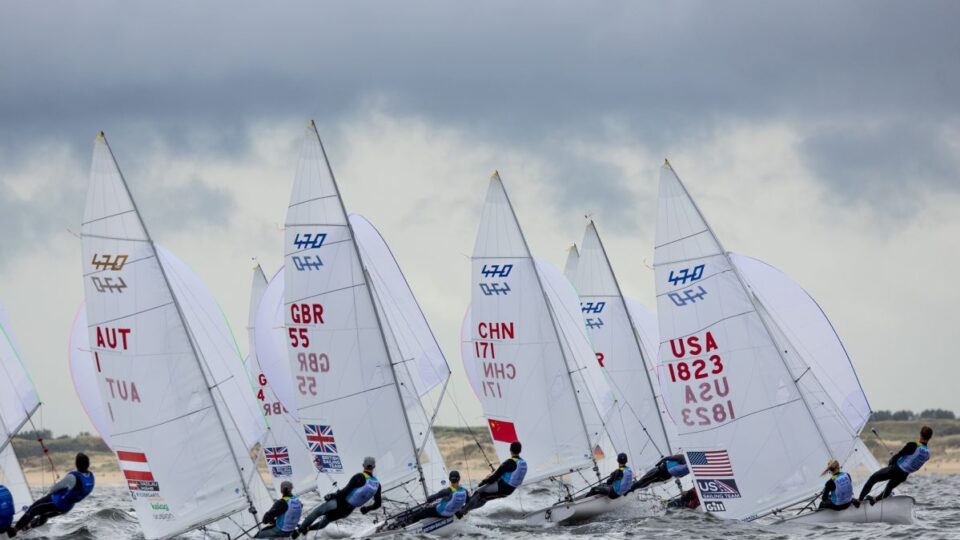

How Does Sailing Work? The Physics of Sailing
Sailing, with its graceful boats skimming across the water powered solely by the wind, is a captivating and ancient mode of transportation and recreation. While it might seem like magic, the principles behind sailing are firmly grounded in physics. The interplay between the wind, the water, and the structure of the sailboat creates an intricate dance of forces that propels the vessel forward. In this article, we will delve into the physics of sailing to uncover the mechanics behind this age-old practice.
The Role of the Wind: Lift and Drag
At the heart of sailing lies the wind – a dynamic force that fills the sails and provides the energy needed to move the boat. The interaction between the wind and the sail is based on the principles of lift and drag, which are also fundamental to aviation and other fluid dynamics.
When wind flows over the curved surface of a sail, it creates an area of lower pressure on the windward side and an area of higher pressure on the leeward side. This pressure difference generates lift, much like an airplane wing. The sail’s shape and angle in relation to the wind determine the amount of lift generated. By adjusting the sail’s angle, sailors can control the lift and subsequently the boat’s direction.
Drag, on the other hand, is the resistance the sail experiences due to the friction between the air molecules and the sail’s surface. While drag can’t be entirely eliminated, modern sail designs aim to minimize it to ensure the boat moves efficiently through the water.
>>Also Read: How Fast Can a Sailboat Go?
The Concept of Apparent Wind
In a straightforward scenario, a sailboat would travel directly downwind with the wind pushing the sails from behind. However, sailing often involves moving at angles to the wind, a concept that introduces the notion of apparent wind.
Apparent wind is the combination of the true wind – the wind blowing over the Earth’s surface – and the wind generated by the boat’s motion through the water. As the boat sails at an angle to the true wind, the wind experienced by the boat appears to come from a different direction and at a higher speed than the true wind. This apparent wind is crucial for maintaining lift on the sails, even when sailing against the true wind direction.
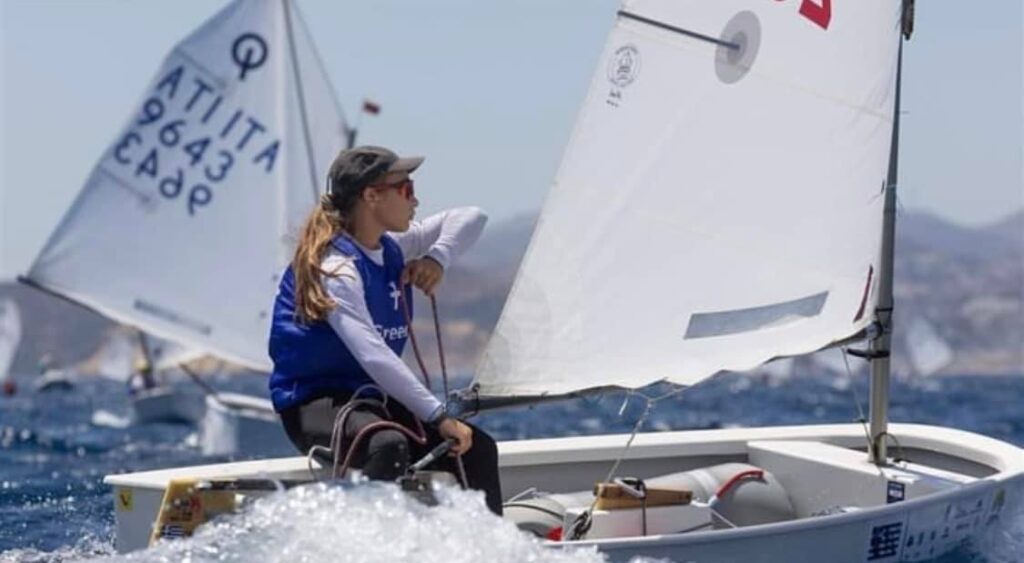
Points of Sail: Navigating the Wind Angles
To understand how sailboats maneuver, it’s essential to grasp the concept of points of sail. These are specific angles at which a boat can sail relative to the wind direction. The main points of sail are:
- Close-hauled: Sailing as closely as possible into the wind. This requires the sails to be trimmed in tightly, and the boat moves forward at an angle against the wind.
- Close reach: Sailing diagonally to the wind, between close-hauled and a beam reach.
- Beam reach: Sailing perpendicular to the wind. This is often the fastest point of sail as the boat can fully capture the wind’s energy.
- Broad reach: Sailing diagonally away from the wind, between a beam reach and running.
- Running: Sailing directly downwind, with the wind coming from behind the boat.
By adjusting the angle of the sails and the boat’s course, sailors can optimize their speed and direction according to the prevailing wind conditions.
>>Also Read: Points of Sail Explained
Balancing Forces: The Keel and Centerboard
While the wind provides the forward propulsion, the boat’s stability and ability to maintain a straight course are maintained through the use of a keel or centerboard, depending on the type of sailboat.
The keel is a heavy, fin-like structure located beneath the boat’s hull. It serves two main purposes: counteracting the force of the wind pushing the boat sideways (referred to as leeway) and providing ballast to keep the boat upright. The keel’s shape generates lift in the water that counters the lateral force of the wind, allowing the boat to sail closer to the wind without being pushed sideways.
For boats with a centerboard, which is a retractable fin located in the center of the boat, the principle is similar. By adjusting the centerboard’s depth, sailors can control the boat’s lateral resistance and stability.
>>Also Read: How do Sailboats Move Without Wind?
Tacking and Jibing: Changing Course with the Wind
Sailing isn’t just about going in a straight line – sailboats can change direction by tacking and jibing.
Tacking involves turning the boat’s bow through the wind so that the wind changes from one side of the boat to the other. This maneuver allows the boat to change direction while maintaining forward momentum. During a tack, the sails are let out to spill the wind’s energy, the bow crosses through the wind, and then the sails are trimmed in again on the new tack.
Jibing, on the other hand, is a maneuver where the stern of the boat crosses through the wind. This is often used when sailing downwind. Jibing requires careful coordination, as the sails can swing abruptly from one side to the other, potentially causing powerful forces.
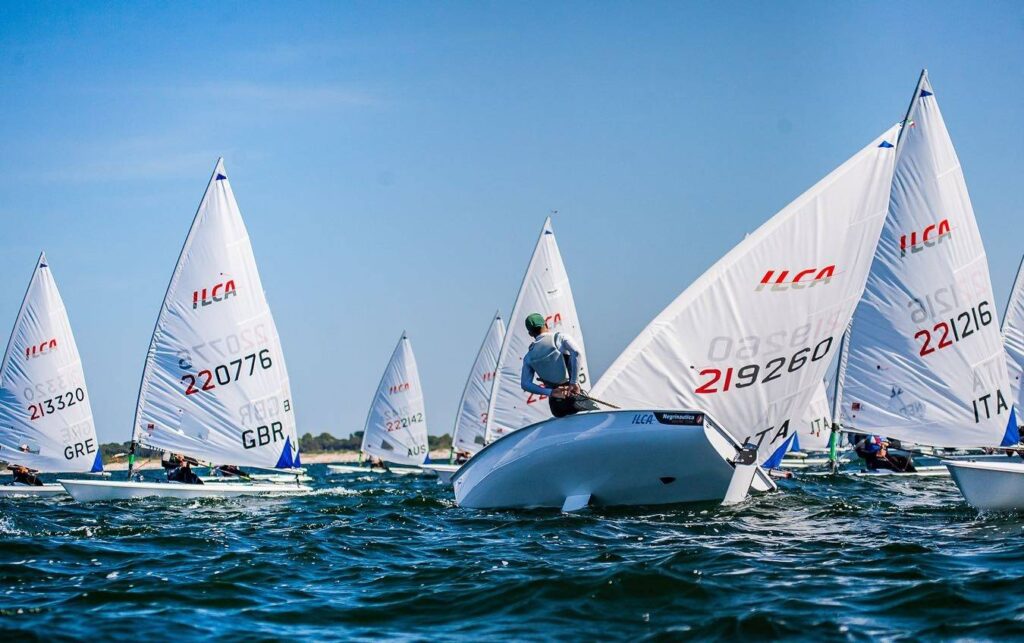
Sail Shape and Rigging: Aerodynamics of Sailing
The shape of the sail and the configuration of the rigging also play a vital role in the physics of sailing. Modern sail designs use a combination of materials and engineering to create sails that are both efficient and durable.
The angle at which the sail is set, known as the angle of attack, determines the amount of lift and drag produced. Sails are typically designed with a curved shape, known as camber, which allows for better lift generation and minimizes drag. Adjustable controls such as the cunningham, outhaul, and boom vang enable sailors to modify the shape of the sail according to wind conditions.
The mast, rigging, and other structural elements of the sailboat are designed to distribute forces evenly and provide stability. The tension in the rigging affects the shape of the mast, which, in turn, affects the shape of the sail. Balancing these factors ensures optimal sail performance and boat stability.
>>Also Read: Most Common Sailing Terms
How Does Sailing Work? The Physics of Sailing – In Conclusion
Sailing is a captivating interplay of physics and nature, where the wind’s energy is harnessed to propel a boat gracefully across the water. By understanding the principles of lift, drag, apparent wind, and the mechanics of sail shape and rigging, sailors can navigate the seas with precision and finesse. From the ancient mariners who first ventured out onto the open waters to the modern sailors competing in high-tech races, the physics of sailing remains a timeless and essential art.
Peter is the editor of Better Sailing. He has sailed for countless hours and has maintained his own boats and sailboats for years. After years of trial and error, he decided to start this website to share the knowledge.
Related Posts

Atlantic vs Pacific: Which is More Dangerous for Sailing?

Why Do Sailboats Lean?

How Does a Boat Sail Upwind? Unveiling the Mechanics of Against the Wind Sailing
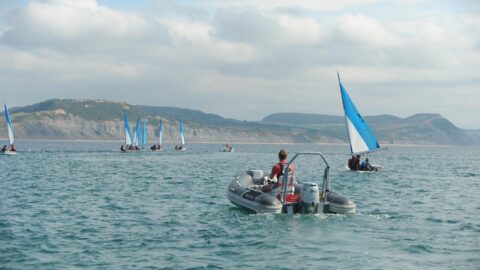
Best Sailing Certifications – Which Sailing Certification is Better?
- Buyer's Guide
- Destinations
- Maintenance
- Sailing Info
Hit enter to search or ESC to close.
How Do Sails Actually Work: Full Beginners Guide
The sails are your boat's primary driving force. Your boat is designed to sail , and with good wind it will be faster and more comfortable than using the engine. Engines on sailboats are called "auxiliary" for a reason, almost every sailor hates to use them once they get the hang of sailing. But it won't happen if you don't learn to trim the sails, and to trim them you have to understand them.
But how does a bunch of cloth - your sails - get so much motive power and force? How do sails actually work?
The short answer is that upwind sails generate lift which acts against forces on the keel in the water to pull the boat forward, and downwind sails capture as much wind force as they can to push the boat downwind.

On this page:
How sailing requires some math, understanding the physics of sailing, putting math and physics together under sail, why is it easier to sail downward, applying your knowledge of sails.
But the detailed answer for sailing upwind is more complex, so come join us for a deep dive into the reason sailboats work and can sail up, down, and across the wind. It's going to get a little into math and a little physics, but we'll keep it on a practical level where you can get the concepts with little hard stuff. And downwind sails are much easier to explain.
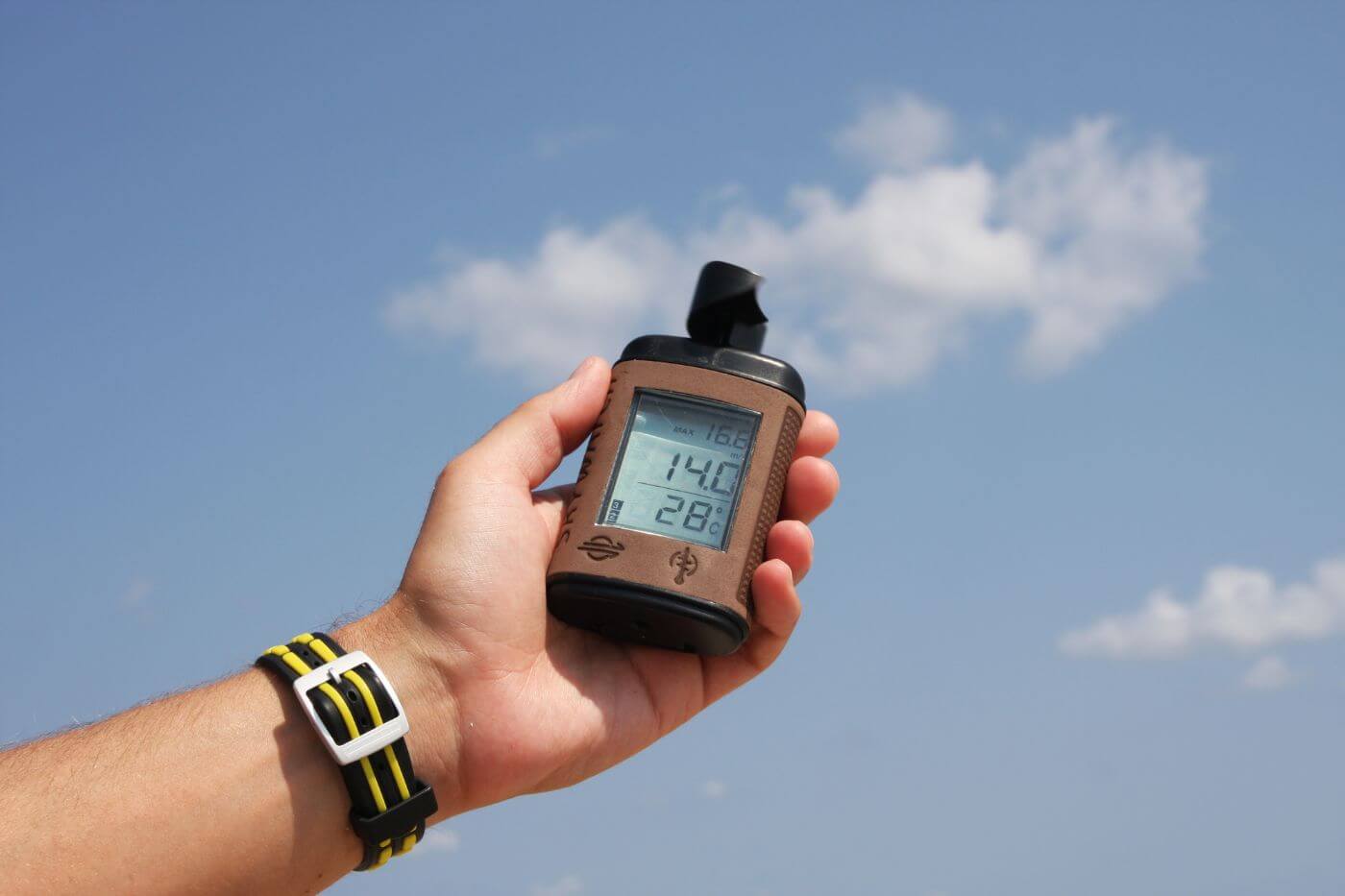
To understand sails and sailing, understand the forces which apply to a boat and how they combine to make forward motion. To represent forces, motion, and velocity, we need to use vectors .
We'll do our best to keep this simple, and you will not need a calculator. The important takeaway is how we add forces together to figure a net force or motion .
What is a Vector?
A vector is a number with both a magnitude (a number or size) and a direction. Traveling at 60 miles per hour down the highway is a speed—the car's speed is 60 mph no matter where it’s headed. It has no direction component. But traveling west at 60 mph is a velocity , which is a speed and a direction (west).
You represent the speed easily with a number: "60." But how do you show its velocity headed west? Just as easily, with a vector.
Draw a six-inch line running east/west, then put an arrow on the west end. If we set our scale to one inch = 10mph, then we have our scalar measurement (6") and our orientation - west, or 270°. This arrow is the velocity vector of a car moving at 60mph headed west.
You can represent anything with an orientation and a scalar measurement this way. Whether it's the force and direction a pool cue applies to a ball, the force a hammerhead puts on a nail or the speed and direction of the wind, you can show it with vectors.
Calculating the sailing vector (with pictures)
So what is the point of drawing arrows to describe things? If we can describe forces with vectors, then we can add and subtract the vectors to see how the forces add and subtract, too.
Adding vectors is simple. To add two vectors, put the arrow end of the first vector at the beginning of the second vector. Then, with a straight edge, draw a line from the start of the first vector to the end of the second and put an arrow on the end where it meets the second vector. That new line you just drew is the sum of the vectors.
That's all there is to it. But what does it mean? Let's do a couple of thought exercises to show how it works.
Picture a bicyclist riding north along a road at 20 mph with no wind. The bicyclist feels a 20 mph north wind in her face, right? You can draw that as a line 20 units long pointing directly at the rider's face. The exact units on paper don't matter. That they're consistent is all that counts, so "one square of graph paper = one unit" and "one unit equals one mph" is just fine.
Now picture a 10 mph north wind from straight in front of the rider. What does it feel like to the rider?
That 10 mph wind is added to the 20 mph wind, and it feels like the rider is moving into a 30mph wind. You don't need vectors to see this, it's simple math, and you know how this feels. Just like you know a 10 mph south wind from straight behind the rider will make the total wind feel like just 10 mph.
But what about if there's a 10 mph wind from the east - 90 degrees from the rider's right? What does the wind force feel like in her face now?
- Draw your 20-unit north wind line in the rider's face.
- From the end of the first line, draw a 10-unit east wind.
- With a straightedge, draw a line from the beginning of the north wind vector to the arrow on the east wind vector.
- That line is what the rider feels in her face from the combined wind of her motion on the bike and the 10 mph east wind.
- You can measure the exact angle of the new vector with a protractor or compass and measure the length in units to get the wind strength. You'd get a wind that felt like 22.4 mph from 26.6° to the rider’s right.

Vector A, the north wind (0°) 20 mph long, and B is the east wind (90°) at 10 mph
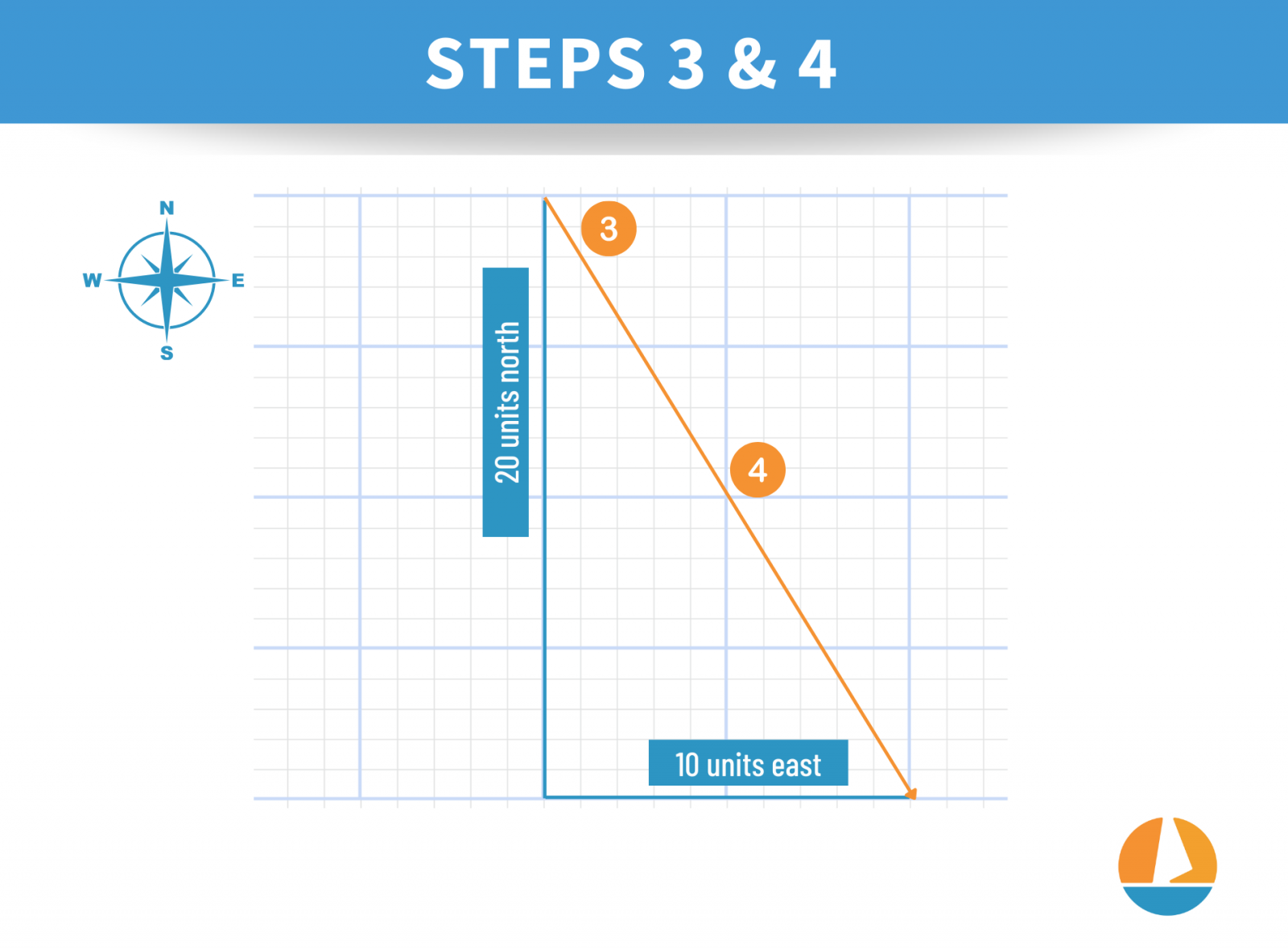
The line is drawn to add them together.

The new vector for the wind force.
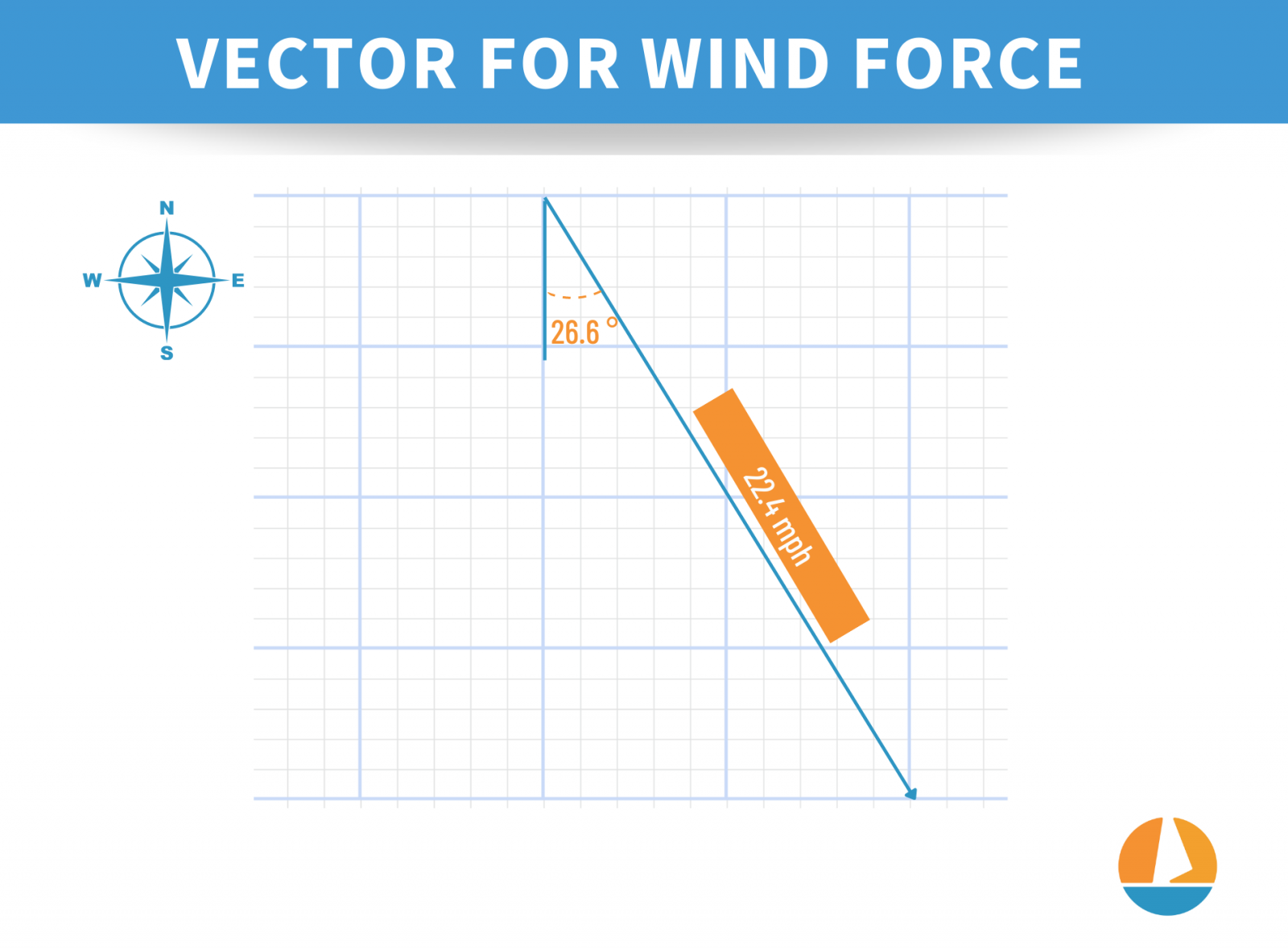
To explore this further, check out the tool used to make these graphics , where you can create your own vectors and add them together. Just remember it's made by mathematicians, not sailors, so North (0°) is to the right instead of up!
Applying vectors when sailing
You don't need to understand how to measure vectors or even do the math to get all the numbers. All you need to understand is how to add the forces together with the arrows.
Lay them head-to-tail and draw the new line. And that's enough for you to see how the combined forces will look without using a calculator.
Vectors are an important part of understanding sailing. When you learn to navigate, you'll use vectors to calculate the current set and drift or the course to a waypoint (though they won't call it that!). From our examples, you see how they apply to understand apparent wind. You don't need to draw lines on paper all the time, but understanding how forces, currents, and wind affect each other will make you a better sailor.
Now that we know how to measure and add forces, we can talk about the forces on a boat that create upwind motion. There are a few basic physics principles that describe and explain these forces and how they apply to a sailboat. If you never took physics back in the day (or you remember as well as most of us do years later...) don't sweat. We'll keep it relatable.
What is the Bernoulli Effect?
Standing near a chimney, you can feel flue drafts that suck the heat right out of the room if you leave it open, or see them suck smoke up the chimney. And if you've ever flown, did you ever look out the window at what the wing was doing during the flight? Ever wonder how the wings get that big jet plane off the ground?
The answer lies in the work of Daniel Bernoulli, an 18th-century Swiss mathematician. Bernoulli's Principle states that a moving fluid is associated with a decrease in static pressure. The faster the flow, the lower the pressure near it.
At lower speeds, the air is effectively fluid, and the same rules apply. So wind moving over a chimney opening creates a low-pressure spot at the top of the chimney, which draws air up the chimney even when there is no fire. On a windy day, this force is powerful enough to rattle the flue cover when it's closed.
How the sail generates lift
How does this get a plane in the air? And by extension, how does it get power to a sail? Because the same principle applies and upwind sails are very similar to airplane wings.
An airplane wing is a curved surface. As air flows over a curved surface, the air on the outside of the curve has a longer path to travel than air on the inside before it meets again at the back of the wing. Both sides of the wing are moving through the air at the same speed, so the air over the top of the curve must move faster than the air on the bottom.
The faster a fluid moves, the lower the pressure. So the faster air on top of the wing has lower pressure than the bottom, which leads to a lifting force from the higher pressure under the wing. The curve of a wing causes the lifting force towards the top of the wing. The same thing applies to upwind sails - the curve in the sail generates "lift" towards the outside of the sail.
If you want to feel this yourself, the next time you're a passenger in a car, roll down the window and put your hand. Flatten your hand with your palm down parallel to the ground. Then, slowly curve your hand and feel the lifting force!
How the sailor controls lift
If you've watched the wing while a plane takes off or lands, you've seen the pilot adjusting the flaps and the overall shape of the wing. A modern plane wing changes shape from a low-flat profile to a shorter, thicker shape. This different shape changes the amount of lift the wing gives, and the thicker shape has more lift, which helps at takeoff and landing.
The pilot is trimming the wing like a sailor trims a sail.
In a curved surface like an airplane wing (or sail), the chord is the curve's height. The fuller the curve, the longer the chord. And the faster the wind has to travel over the outside to meet the inside wind, which leads to more lift. But it also creates more drag, so once a plane is off the ground and getting closer to cruising speed, the pilot flattens out the wing to reduce drag for higher speed.
For airplanes, this makes taking off and landing easier since the plane can get off the ground and land at lower speeds. For sails, it gives more power for acceleration from low speed or through waves and chop.
What is Newton's Third Law of Motion?
"For every action, there's an equal and opposite reaction."
If you push against a wall, the wall pushes back with the same force. If it didn't, the wall would fall over. A rocket blasts hot gasses from burning fuel out of the bottom, and the rocket moves forward from the reaction force. A car's tires push against the road, the road pushes back, and the car moves forward.
When wind hits a boat's sails, it will either flop over and capsize or skitter sideways through the water unless it has a keel or other appendage under the water . A mono-hulled boat without a keel, centerboard, daggerboard, or other underwater stabilizers can not sail upwind.
So the keel acts as a counterpoise to the forces on the sails to keep the boat upright, but it also pushes against the water. This pushing against the water and the sails is an action, and there's an equal and opposite reaction. This force works against the sail lift to move the boat.
Sailing upwind, you've got a combination of lifting force from the sails, reactive force from the keel against the water, and other forces, like friction and drag from the water. These forces have their own vector arrows.
For simplicity, we will ignore friction and drag, since they're the only forces pushing against the boat in one direction as it moves through the water. While they increase with speed, we can assume the other forces are large enough to overcome them. And you don't want to make me explain adding four or five vectors together at once...
Friction and drag are very important to boat performance. We've simplified them out of the equation to make the force diagrams clearer. Faster boats have less drag from hull form and smooth bottoms, but all the drag and friction vectors point straight back against the boat's forward motion so they only slow the boat down, not change its direction.
In the diagram below, you can see vectors for the lifting force from the sails and the side force of the keep pushing against the water.
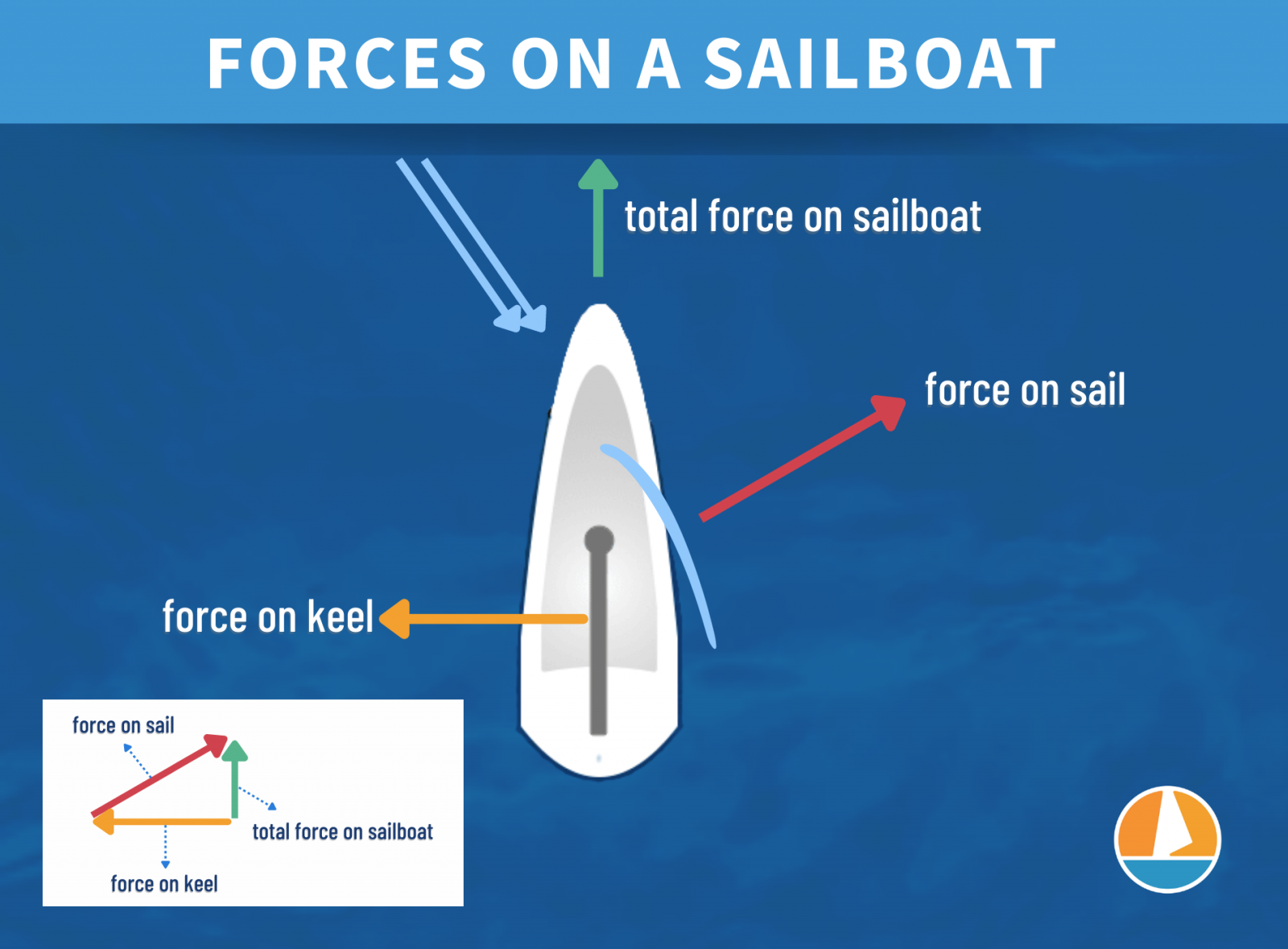
Now, add them.
You don't have to do it on paper, as long as you can see that those vectors, when added together, result in a vector that nets a forward motion of the hull through the water. There's your answer.
Any yacht designer will tell you there's much more to getting the correct forward vector. And this is true. The shape of the hull, the smoothness of the bottom, and a few other factors will affect the final forward forces on the boat.
But at its core, the lift vector from the sails added to the keel vector ends up in the boat being pulled forward.
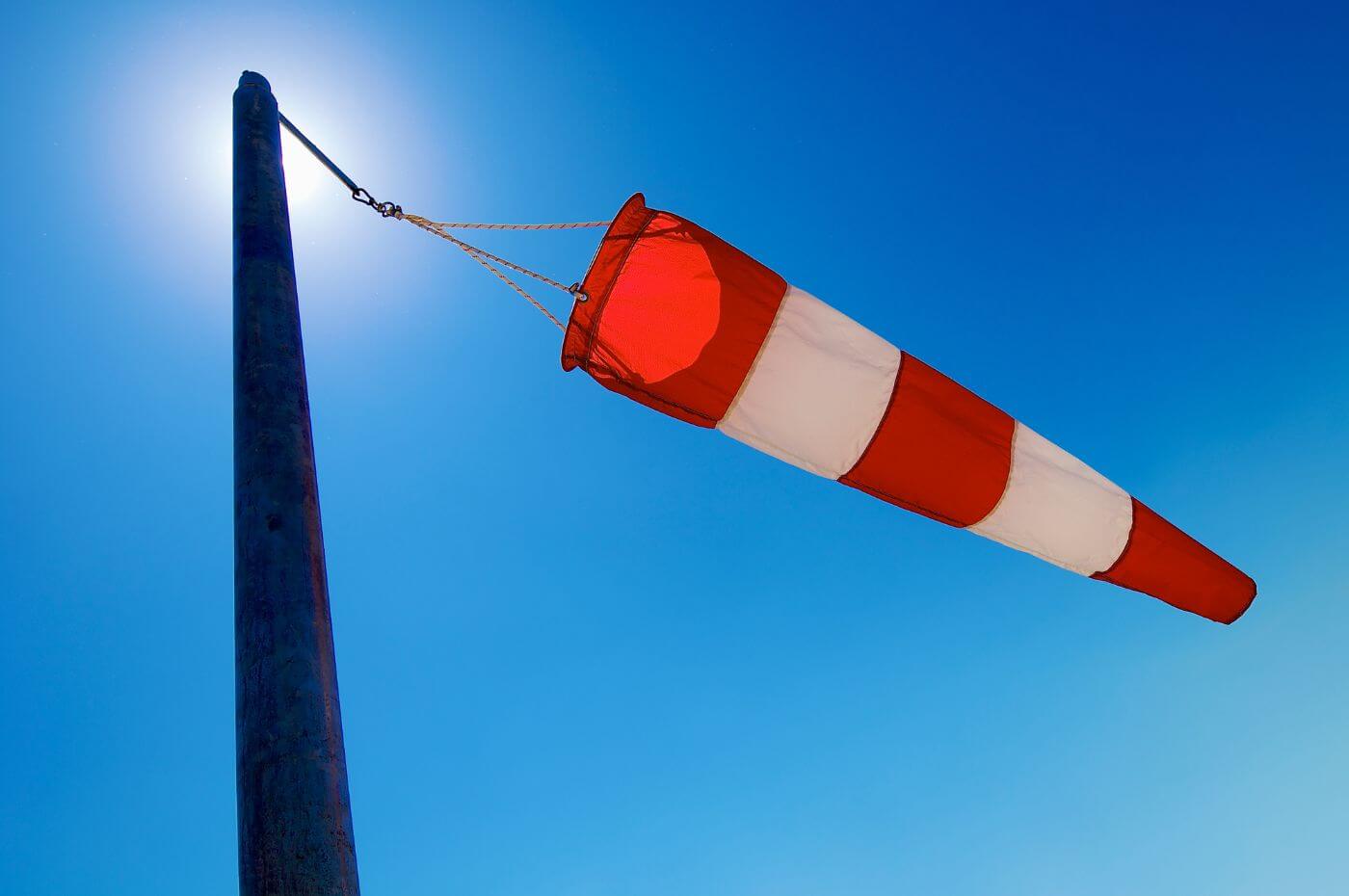
What makes a boat sail downwind is much simpler than the mashup of force vectors we had to work through for upwind sailing. It's quite simple really - the sails fill with wind and pull on the boat to push/drag it downwind.
When you're not going against the wind, the physics is a lot simpler.
Not that you can't look more closely at the forces involved to maximize your speeds and find the best way to sail downwind. But we're not asking how to trim for speed, we're asking how the boat moves. And heading downwind, your full sails catch as much wind as possible to put as much propulsive force onto the hull as possible.
If you've gotten this far, you may wonder "now what?" The next step is to apply that knowledge to sail your boat. Now that you know you can change sail shapes for speed and power and why that works, check out our complete guide to trimming sails so you can trim better and sail faster.
Leave a comment
Own your first boat within a year on any budget.
A sailboat doesn't have to be expensive if you know what you're doing. If you want to learn how to make your sailing dream reality within a year, leave your email and I'll send you free updates . I don't like spam - I will only send helpful content.
Ready to Own Your First Boat?
Just tell us the best email address to send your tips to:

- Repeated Customers
- Booking Request
How do sailboats sail upwind?
Yachts aren’t blown along – they are ‘sucked along’.
The sail creates a low pressure zone in front of the sail and a high pressure zone behind the sail.
The boat moves into the low pressure zone and is sucked forward.
This is very like the idea of an aeroplane wing , which is curved in a similar way to a sailboat’s sail as you can see below.
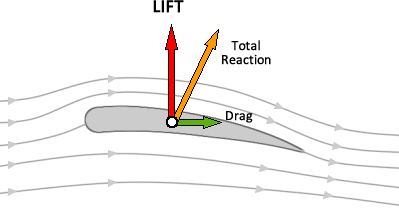
In airplane wings, the pressure on the top of the wing is less than the pressure on the bottom of the wing, because the air moves faster on the top , so this difference in pressure creates a force on the wing that lifts the wing up into the air.
The curve on the sail makes the air travel a longer distance over the top of the wing and a shorter distance behind it.
The longer distance the air flows, the lower the pressure, and this is why the aircraft climbs into the sky.
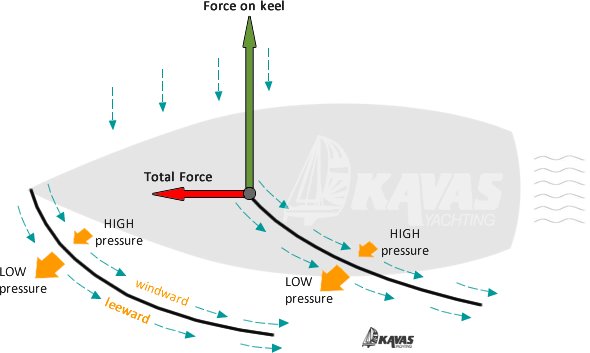
Below the level of the water on the boat, the sailboat’s shape helps force the boat to go straight forward as opposed to in the direction of the wind.
In addition you have the keel that is shaped like a wing, and has a lot of weight to stop the yacht from falling over when pushed sideways by the wind.
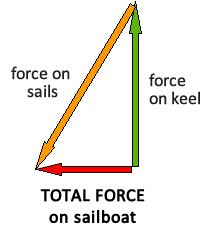
With the sails being unable to push the boat sideways or onto its side, the sails drive the boat forward.

- Random article
- Teaching guide
- Privacy & cookies

What are boats? Not such a silly question! A ship or a boat (we'll call them all boats from now on) is a vehicle that can float and move on the ocean, a river , or some other watery place, either through its own power or using power from the elements (wind, waves, or Sun). Most boats move partly through and partly above water but some (notably hovercraft and hydrofoils) lift up and speed over it while others ( submarines and submersibles, which are small submarines) go entirely under it. These sound like quite pedantic distinctions, but they turn out to be very important—as we'll see in a moment. Why do boats float? All boats can float, but floating is more complex and confusing than it sounds and it's best discussed through a scientific concept called buoyancy , which is the force that causes floating. Any object will either float or sink in water depending on its density (how much a certain volume of it weighs). If it's more dense than water, it will usually sink; if it's less dense, it will float. It doesn't matter how big or small the object is: a gold ring will sink in water, while a piece of plastic as big as a football field will float. The basic rule is that an object will sink if it weighs more than exactly the same volume of water. But that doesn't really explain why an aircraft carrier (made from dense metal) can float, so let's explore a bit further. Sponsored links (adsbygoogle = window.adsbygoogle || []).push({}); Positive, negative, and neutral buoyancy Buoyancy is easiest to understand thinking about a submarine . It has diving planes (fins mounted on the side) and ballast tanks that it can fill with water or air to make it rise or fall as it needs to. If its tanks are completely filled with air, it's said to be positively buoyant : the tanks weigh less than an equal volume of water and make the sub float on the surface. If the tanks are partly filled with air, it's possible to make the submarine float at some middle depth of the water without either rising up or sinking down. That's called neutral buoyancy . The other option is to fill the tanks completely with water. In that case, the submarine is negatively buoyant , which means it sinks to the seabed. Find out more about how submarines rise and fall . Photo: Submarines can rise to the surface or sink to any chosen depth by controlling their buoyancy. They do so by letting precise amounts of water or air into their ballast tanks. Photo courtesy of US Navy . Buoyancy on the surface Now most boats don't operate in quite the same way as submarines. They don't sink, but they don't exactly float either. A boat partly floats and partly sinks according to its own weight and how much weight it carries; the greater the total of these two weights, the lower it sits in the water. There's only so much weight a boat can carry without sinking into the water so much that it... does actually sink completely! For ships to sail safely, we need to know how much weight we can put in or on them without getting anywhere near this point. So how can we figure that out? Archimedes' Principle The person who first worked out the answer was Greek mathematician Archimedes, some time in the third century BCE. According to the popular legend, he'd been given the job of finding out whether a crown made for a king was either solid gold or a cheap fake partly made from a mixture of gold and silver. One version of the story says that he was taking a bath and noticed how the water level rose as he immersed his body. He realized that if he dropped a gold crown into a bath, it would push out or "displace" its own volume of water over the side, effectively giving him an easy way to measure the volume of a very complex object. By weighing the crown, he could then easily work out its density (its mass divided by its volume) and compare it with that of gold. If the density was lower than that of gold, the crown was clearly a fake. Other versions of the story tell it a slightly different way—and many people think the whole tale is probably made up anyway! Later, he came up with the famous law of physics now known as Archimedes' Principle: when something is resting in or on water, it feels an upward (buoyant) force equal to the weight of the water that it pushes aside (or displaces). If an object is completely submerged, this buoyant force, pushing upwards, effectively reduces its weight: it seems to weigh less when it's underwater than it does if it were on dry land. That's why something like a rubber diving brick (one of those bricks you train with in a swimming pool) feels lighter when you pick it up from underwater than when you bring it to the surface and lift it through the air: underwater, you're getting a helping hand from the buoyant force. All this explains why the weight of a ship (and its contents) is usually called its displacement : if the ocean were a bowl of water filled right to the brim, a ship's displacement is the weight of water that would spill over the edge when the ship were launched. The USS Enterprise in our top photo has a displacement of about 75,000 tons unloaded or 95,000 tons with a full load, when it sits somewhat lower in the water. Because freshwater is less dense than saltwater, the same ship will sit lower in a river (or an estuary—which has a mixture of freshwater and saltwater) than in the sea. Photo: This relatively small container ship can carry 17,375 tonnes (metric tons) of cargo. The biggest container ships carry over ten times more (around 200,000 tonnes). Photo by Laura A. Moore courtesy of US Navy and archived on Wikimedia Commons . Upthrust Artwork: The weight of a ship pulling down is balanced by upthrust—the pressure of the water underneath, pushing up. Unfortunately, none of this really explains why an aircraft carrier floats! So why does it? Where does that "magic" buoyant force actually come from? An aircraft carrier occupies a huge volume so its weight is spread across a wide area of ocean. Water is a fairly dense liquid that is virtually impossible to compress. Its high density (and therefore heavy weight) means it can exert a lot of pressure: it pushes outward in every direction (something you can easily feel swimming underwater, especially scuba diving). When an aircraft carrier sits on water, partly submerged, the water pressure is balanced in every direction except upward; in other words, there is a net force (called upthrust ) supporting the boat from underneath. The boat sinks into the water, pulled down by its weight and pushed up by the upthrust. How low does it sink? The more it weighs (including the weight it carries), the lower it sinks: If the boat weighs less than the maximum volume of water it could ever push aside (displace), it floats. But it sinks into the water until its weight and the upthrust exactly balance. The more load you add to a boat, the more it weighs, and the further it will have to sink for the upthrust to balance its weight. Why? Because the pressure of water increases with depth: the further into the water the boat sinks, without actually submerging, the more upthrust is created. If the boat keeps on sinking until it disappears, it means it cannot produce enough upthrust. In other words, if the boat weighs more than the total volume of water it can push aside (displaces), it sinks. Upthrust—made simple
How do we know that the upthrust on something is equal to the weight of fluid it displaces.
Photo: The simplest way of understanding why things float is to forget about Archimedes and think instead about density. A ship floats because its average density is relatively small. This empty military transport ship is effectively a giant empty metal box. Divide its total mass (its own mass plus that of its contents) by its volume and you get its average density. That's less than the density of a solid metal box or a metal box filled with water, and that's why the ship floats. Photo by Gary Keen courtesy of US Navy .
Middle Ages
The great age of shipping, modern ships.
If you liked this article...
Find out more, on this website.
- Jet Ski® and Sea-Doo®
Practical books
For younger readers.
Text copyright © Chris Woodford 2012, 2021. All rights reserved. Full copyright notice and terms of use .
Rate this page
Tell your friends, cite this page, more to explore on our website....
- Get the book
- Send feedback
Advertisement
How Sailboats Work
- Share Content on Facebook
- Share Content via Email
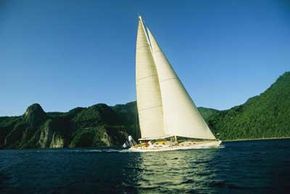
Sailboats are one of humankind's first and most revolutionary transportation inventions. Powered mainly by the wind, these simple but incredible machines opened up new pathways for international trade, exploration and cultural exchange, which shaped the modern world.
Although no one knows when the first sailboat was built, archeologists have found remains of primitive canoe-like vessels dating back to ancient Egypt and Mesopotamia. Since then, boat design has developed steadily to enhance speed, maneuverability and cargo load, reflecting unique aesthetic and technological innovations.
For example, to construct their signature dragon-headed boats, Vikings used axes rather than saws to cut longer, lighter pieces of wood that allowed for faster travel. These longboats, called drakkar , dominated the seas by taking advantage of wind in their square sail for long distances and of oarsmen for swift attacks [source: Hadingham]. Later, 15th-century Chinese junk boats with their distinct scalloped sails were so well-crafted to withstand regional typhoons that they reached the east coast of Africa and the Persian Gulf more than 50 years before European explorers [source: University of Calgary ]. Today, specialized racing yachts slice through the water at speeds faster than the wind.
While these amazing ships range in size and capability, all are linked by the fundamental elements of the common sailboat. Whether large or small, vessels of the past and present share the same flotation and movement abilities. In this article, we are going to explore how the basic parts of a sailboat work together, how physics principles allow them to float and move and how sailboat design continues to evolve.
Basic Parts of a Sailboat
How sailboats float, how sailboats move in the water, the physics of lift, a closer look at the sailboat keel, sailboat speed, modern sailboat design.
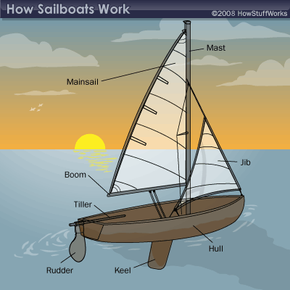
The common sailboat comprises eight essential parts: hull, tiller, rudder, mainsail, mast, boom, jib and keel. The hull is the shell of the boat, which contains all the internal components. Its symmetrical shape balances the sailboat and reduces drag , or the backward pull caused by friction, as it moves in the water. Inside of the hull in the stern , or back of the boat, is the tiller, which is attached to the rudder in the water. Think of the tiller as the boat's steering wheel and the rudder as the tire. To maneuver a sailboat to the right, for example, you pull the tiller to the right side of the boat, causing the rudder to alter its direction.
If you think of the tiller as the steering wheel, then the sails and the keel are the engines. The mainsail is the larger sail that captures the bulk of the wind power necessary to propel the sailboat. Its vertical side attaches to the mast , a long upright pole, and its horizontal side secures to the boom, a long pole parallel to the deck. Sailors can rotate the boom 360 degrees horizontally from the mast to allow the mainsail to harness as much wind as possible. When they pivot the boom perpendicular to the wind, the mainsail puffs outward. Conversely, it goes slack when swung parallel to the wind. This freedom of movement allows sailors to catch the wind at whatever angle it blows. The jib is the smaller, fixed triangular sail that adds additional power for the mainsail. The keel , a long, slim plank that juts out from the bottom of the hull, provides an underwater balancing force that keeps the boat from tipping over. In smaller sailboats, a centerboard or daggerboard serves the same purpose as the keel, but can be raised or lowered into the water to allow for shallow water sailing.
Before a boat can move in the water, it first must be able to float. In the next section, we'll discover how something as heavy as a sailboat can stay afloat.
If the Jetsons owned a yacht, it would probably look a lot like the Maltese Falcon. The prized possession of Silicon Valley venture capitalist Tom Perkins, the Maltese Falcon is like a sailing computer, equipped with fiber-optic networks, microprocessors and touch screens that have converted the brain and muscle of sailing into a computerized control panel. Now, the only manpower required to hoist and lower its 26,000 square feet of sails is a touch of a button. Likewise, the football-field-sized yacht completed in spring of 2006 is the most expensive and technologically advanced of its kind today. With a price tag hovering around $130 million, the Maltese Falcon navigates more like a video game than a 1,367-ton boat. But Perkins isn't stopping there. He's working on a sports submarine to house on the Maltese Falcon in case he ever wants to play with some whales or manatees deep in the ocean. Think of it as his version of a jet ski.
Floating depends on two things: displacement and density . Archimedes' principle , which explains the concept of buoyancy, states that in order for an object to float, it must displace an amount of water equal to its weight. As a sailboat's weight pushes downward and displaces water beneath it, an upward force equal to that weight holds the boat up.
Here's where density comes into play. To displace enough water to remain afloat without becoming submerged, a boat must have an average density less than water. For that reason, the hull of the boat is hollow. Whether the boat is made of concrete or fiberglass, its average density is less than water. Think about it: If you put a basketball and a bowling ball in a swimming pool, the air-filled basketball has an average density much less than that of water, so it will float. The solid bowling ball, however, will sink immediately. This is how anything from a small sailboat to an aircraft carrier can manage to stay on top of the water.
Surface area also helps to keep the boat afloat. More surface area gives an object a better chance to displace enough water to offset its own weight. For instance, a small ball of clay likely will sink before it can displace the amount of water equal to its weight. But if you flatten the ball into a thin pancake, there is more surface area to distribute the weight across and displace the water, so it will float. For more information on precisely how a steel ship can float, read how boats made of steel float on water when a bar of steel sinks.
Now that we know how sailboats can float, we can learn how they zip through the water.
Simple. Look at the nutrition facts. An average can of regular soda contains about 40 grams, or 20 teaspoons, of sugar, which increases its average density. The diet soda only contains artificial sweeteners. These sweeteners are much more concentrated than sugar so it takes less to sweeten the soda. As a result, the diet soda's average density is less than the regular soda's. That lighter average density allows the diet soda to float.
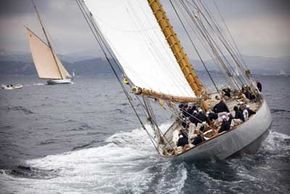
Sailing a boat is simple when you're navigating downwind with the wind at your back. You let out the mainsail perpendicular to the wind to capture the most energy. As the wind presses directly into the sails to make them puff out, that natural force propels the boat forward.
Plotting an upwind course, against the wind, is much harder. Compare the difference between running with the wind behind you and running with the wind gusting at you. You exert more energy to run into it, rather than enjoying the gentle push of it at your back. In fact, it is impossible to sail directly upwind. Either the opposing force of the wind will push the boat backward if the sails are let out, or it will stall the boat if the sails are pulled in and slack. Sailors refer to this as being in irons . Instead, to reach an upwind destination, crews use a method calling tacking .
While the wind pushes the boat when going away from it (downwind) the opposite happens when going toward it (upwind). "When you sail upwind, the boat is actually being pulled rather than pushed by the force of the wind," says Bryan Kelly, sailing instructor at Sail Newport and membership assistant with US Sailing , the national governing body of sailing in the United States. That forward pull is referred to as lift . For that reason, sailors steering upwind must take a zigzagging path called tacking. By doing so, the wind approaches at an angle rather than head-on.
When tacking, the sails act as the engine of the boat, harnessing wind power. However, since the boat is moving angled to the wind, that wind power pushes the boat sideways. But remember that the wind isn't the only element the boat interacts with. There's also the water. As the boat tips to one side, the long, flat keel submerged underneath the hull, pivots upward with the motion of the boat, creating a sideways force in the opposite direction because of the amount of water it displaces as it moves.
When tacking successfully, these equal, opposing sideways forces cancel each other out. However, that collected wind power must go somewhere, so it is released in a forward thrust -- there is nowhere else it can go. This is the same type of effect that happens when you shoot a marble. Your finger and thumb press equally hard on either side of the marble, causing it to zip forward.
After this happens, the sailor would alter course and tack again toward the opposite direction to gradually move upwind.
In the next section, we'll dissect the physics of lift that pull sailboats forward into the wind and what they have in common with kites.
[Source: Cox ]
- Starboard - on the right side
- Port - on the left side
- Stern - back of the boat
- Bow - front of the boat
- In irons - when the boat is going directly upwind and can't catch wind in the sails
- Luff up - direct the sailboat into the wind
- True wind - the speed and direction of the wind as felt by a bystander on shore
- Apparent wind - what you feel while the ship's moving; a combination of the true wind and the wind that the boat's motion creates.
- Trim sails - setting sails for maximum efficiency
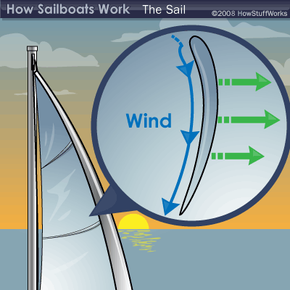
When you see a kite catch the wind and swoop up into the air, you're witnessing lift . You can feel the forward acceleration in the pull on your end of the string. Likewise, the mainsail and jib harness wind energy with their aerodynamic shapes that puff out on one side when the wind hits them. You also might notice that the kite flies angled to the wind, just as the mainsail and jib capture wind when tacking.
Sailing aficionados use two prominent -- yet often disputed -- theories to explain how exactly the wind interaction generates lift: Bernoulli's theorem and Newton's Third Law.
Bernoulli's theorem, also called the Longer Path Explanation , explains lift in terms of high and low air pressures on either side of the sail. Imagine the front of the boat angled upwind, or into the wind. As the breeze hits the sails, the air particles rush over both sides. Theoretically, the air particles moving across the outer, convex side of the sail have a longer distance to travel in the same amount of time as the particles moving across the inner, concave side.
If the particles on the outer side are traveling farther in the same amount of time, they must have a higher velocity, or speed, than the particles on the other side. These higher-velocity particles have more room to spread out, forming a low-pressure area. On the inside of the sail, the slower air particles are packed together more densely, creating a higher-pressure area. This difference in the pressure on the sails acts as a forward suction, producing lift.
Lift also applies to airplane flight. For a more detailed explanation of lift and the Bernoulli and Newtonian theories, read How Airplanes Work.
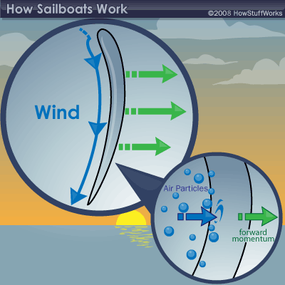
Newton's Third Law describes lift in terms of the reaction of the wind's air particles to the mainsail and jib. The law states that every action has an equal and opposite reaction. As the wind hits the sails from an opposing direction (remember, you're sailing upwind to tack), it generates drag , or backward pull. Drag is parallel to the original wind current [source: Swimmers wear specialized suits and caps to reduce drag as much as possible in the water.
Examining lift through the Newtonian lens, the air particles' movement creates an equal, opposite reaction -- or forward pull. It can also be applied to the interaction of the sails and the keel, described in the previous section. The sails and the keel create equal and opposite reactions to focus the boat's energy forward rather than sideways.
Now we'll examine the keel more in depth to see how it contributes to lift and keeps the boat from tipping over when tacking.
Although the date the world's first sailboat was built is unclear, in 2002 British and Kuwaiti archeologists discovered what they believe to be the oldest known boat remains in As-Sabiyah, Kuwait. The remains date back to around 5400 B.C., according to a Science Magazine article by Andrew Lawler. The supposed vessel is plank-shaped and constructed from reeds and bitumen, a gummy substance similar to tar. While carbon dating has verified its age, some researchers remain dubious about whether the object was indeed a boat.
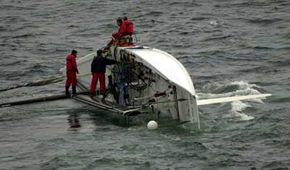
The keel has two main functions: to keep the boat from being blown sideways in the wind (lateral resistance) and to hold the ballast. The ballast is a weight traditionally at the bottom of the keel that keeps the boat right-side up.
When the sails interact with the wind, a lot is also happening underwater to help create lift and allow the craft to recover from tacking. When a boat heels , or tips sideways in one direction when tacking, the ballast prevents it from going completely over. Positioned beneath the sailboat toward the center of the hull's underbelly, the keel's broad, flat surface creates sideways force by displacing water in the opposite direction that the boat is tipping. Although the keel has a much smaller surface area than the sails, the density of the water allows it to initiate a force strong enough to cancel out the heeling motion. That resulting equilibrium is called the righting moment .
You're probably familiar with the strong force of the keel if you've used a canoe paddle to change a canoe's direction. Although the paddle has a relatively small surface area, when turned against the current, you can feel the strength of its resistance as it becomes harder to hold.
Given this delicate balance among the wind, water and boat, sailors must tack carefully to avoid capsizing the boat, monitoring the angle at which they tack. If they tack the boat at too tight of an angle, the force of the wind will be too great for the keel and the water to overcome.
The maximum angle that a boat can tack and recover from is 30 degrees [source: US Sailing]. Sailors can tell the angle at which they approach the wind thanks to telltales , or strands of yarn-like material attached to the mainsail. Depending on how they blow when the sails are pulled tightly, they reveal the angle to the wind. Ideally, they will blow straight out, indicating even airflow across the sails and the optimum tacking angle. This is referred to as banging the corners , or sailing efficiently.
Read on to learn just how fast these wind machines move.
Here are a few sailing-related sayings in case you ever find yourself tongue-tied at sea.
Toe the line : Planks in wooden ships were sealed with a dark substance, giving the appearance of a striped deck. When ordered to line up, crews would keep themselves aligned by stepping their toes directly up to one of those stripes.
Boot camp : A training camp for Navy or Marine recruits. The term originated from sailors fighting in the Spanish-American War who wore leggings called boots.
Down the hatch : Comes from the idea of cargo being loaded down into the hatch below the deck.
Show one's true colors : Warships would try to deceive their enemies by hanging different countries' flags. However, to open fire on an enemy, the civilized rules of war required them to fly their nation's true flag.
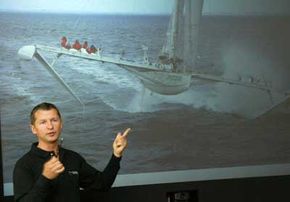
Now that we understand how the boat moves, let's get to the good stuff: speed. A vessel's top speed will vary, depending on its size and purpose. For instance, sleek racing sailboats are designed specifically to maximize speed, but larger, bulkier ships will plod along more slowly due to drag and friction.
The nautical measurement of speed is the knot. One knot is equal to about 1.15 mph. According to the Earth. You can read more about how nautical miles compare to miles and kilometers by reading What is a nautical mile?.
Since Thebault was going 48 mph, you may be wondering if that means the wind was blowing that fast. Probably not. Thebault likely was moving faster than the wind because when sailboats create lift, as we discussed earlier, they create their own additional wind, called apparent wind .
It's important to understand that there are two types of wind at work when sailing: true wind and apparent wind. You feel true wind when you're standing on the dock or if the boat anchors. This wind makes the waves in the water. Apparent wind is what you feel while the ship's moving -- a combination of the true wind and the wind that the boat's motion creates. This is the wind that powers the ship.
So it is possible for some boats to beat the wind, particularly slimmer, more aerodynamic models that have less drag or friction in the water, such as yachts and catamarans . But remember, to sail faster than the wind, these types of boats must travel at an angle to it, rather than straight downwind or upwind, to stimulate lift and accelerate apparent wind.
As sailing technology advances, boats are becoming faster and more efficient than ever before.
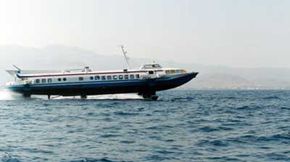
Modern sailboat design has evolved overall to create a wider, yet sleeker, structure. While the width increases stability, other basic components have been refined to improve sailing efficiency.
Keels are often longer and leaner, allowing for a closer, quicker tack . Their larger surface area displaces more water for a tighter tack. The hydrodynamic, slender design cuts through the water with less drag . Likewise, designers have honed the hull to reduce pull in the water. New materials such as energy. Sail shape also has been continually fine-tuned to harness wind.
Due to such innovations, some sailboats, as previously noted, can actually exceed the speed of the wind. Hydrofoils , which elevate the hull above the water, drastically reduce friction between the boat and the water to maximize speed. In short, hydrofoils act like airplane wings on the bottom of boats [source: Getchall]. They have four appendages that resemble water skis with a rounded top attached to each corner of the boat. When stationary, the hydrofoils remain underwater. But as the boat speeds up, they create lift that eventually raises the hull completely above water, leaving only the lighter aerodynamic foils in the water. The same lift principles discussed earlier with the wind and the sails apply as the water rushes over the curved hydrofoils to create the same effect.
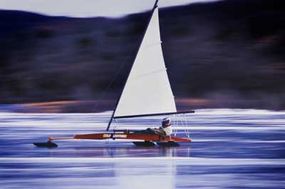
In addition, specialized iceboats that sail on top of ice can travel up to three times faster than the speed of the wind. A Blade Runner iceboat, for instance, can move as fast as 75 mph [source: Blade Runner Ice Boat Company ]. Like a boat on ice skates with a simple hull and sails, iceboats have very little drag as they glide across frozen bodies of water. Not surprisingly, they're especially popular in colder climates such as New England, Canada and Russia.
As the evolution continues as it has for centuries, sailboats will undoubtedly hold their integral place in human life, whether for utilitarian purposes or pure windblown pleasure.
Lots More Information
Related articles.
- How Aircraft Carriers Work
- How Airplanes Work
- How to Maintain a Boat
- Why can boats made of steel float on water when bars of steel sink?
- Why can't you say "toy boat" three times fast?
More Great Links
- National Geographic Sailing Simulator
- Bernoulli and Newton
- Boatsafe Kids
- Boat Safe Kids. (Feb. 12, 2008) http://www.boatsafe.com/kids/033199kidsques.htm
- Cox, David. "The Sailing Handbook." Stackpole Books. 1999.
- Getchall, David R. "The Outboard Boater's Handbook: Advanced Seamanship and Practical Skills." McGraw Hill. 1994. (Feb. 12, 2008) http://books.google.com/books?id=YpMTd7-Mb3sC&pg=PA103&lpg=PA103&dq=hydrofoils+how+do+they+work&source=web&ots=wPcwsdSncw&sig=-Pvjyd6fSF7EHNJrZ2ZJmKSrU84#PPA104,M1
- Glenn Research Center. "Bernoulli and Newton." (Feb. 12, 2008) http://www.grc.nasa.gov/www/K-12/airplane/bernnew.html
- Hadingham, Evan. "Secrets of Norse Ships." NOVA Online. (Feb. 12, 2008) http://www.pbs.org/wgbh/nova/vikings/ships.html
- Hodanbosi, Carol. "Buoyancy: Archimedes Principle." August 1996. Glenn Research Center.
- Hyperphysics. "Bernoulli Principle." (Feb. 12, 2008) http://hyperphysics.phy-astr.gsu.edu/hbase/hframe.html
- Kelley, Bryan. Personal interview. Conducted Dec. 14, 2007.
- Lawler, Andrew. "Report of Oldest Boat Hints at Early Trade Routes." Science Magazine. June 7, 2002.
- MacMillan, Douglas. "The Making of the $30 million sailboat." BusinessWeek Online. Oct. 17, 2006.
- Naval Historical Center. "Nautical Terms and Phrases…Their Meaning and Origin." May 5, 2005. (Feb. 12, 2008) http://www.history.navy.mil/trivia/trivia03.htm
- Pickthall, Barry. "The Color Guide to Sailing." London, Castle & Co. 1980.
- Schryver, Doug. "Sailing School." McDonald/Queen Anne Press.1987.
- University of Calgary. "European Voyages of Exploration: Asia." (Feb. 12, 2008) http://www.ucalgary.ca/applied_history/tutor/eurvoya/asia.html
- US Sailing. "Points of Sail." (Feb. 12, 2008) http://www.smallboat.sailingcourse.com/points_of_sail.htm
- Vawter, Richard. "Floating Diet Coke QT Movie." Western Washington University Physics Department. (Feb. 12, 2008) http://www.ac.wwu.edu/~vawter/PhysicsNet/QTMovies/PressureFluids/FloatingDietCokeMain.html
- Wolf, Joe. "The Physics of Sailing." University of New South Wales. (Feb. 12, 2008) http://www.physclips.unsw.edu.au/jw/sailing.html
- World Sailing Speed Record Council. "Nautical Mile Records." (Feb. 12, 2008)http://www.sailspeedrecords.com/
Please copy/paste the following text to properly cite this HowStuffWorks.com article:

- Outdoor Activities
- Destinations
- Book Hotels, Flights & Cars
- Advertise With Us
- Cookie Settings
Copyright © 2024 MapQuest Holdings LLC, a System1 Company
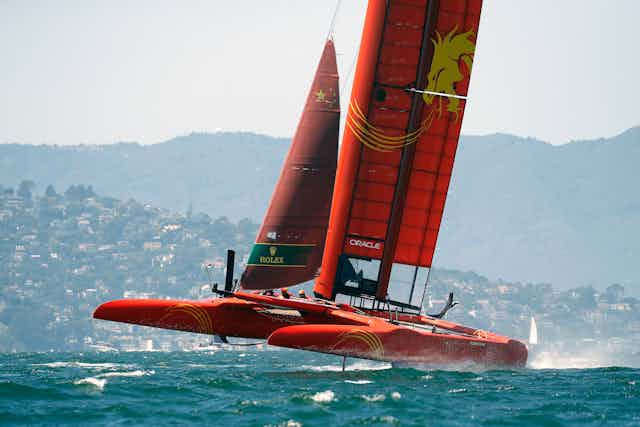
Sail GP: how do supercharged racing yachts go so fast? An engineer explains
Head of Engineering, Warsash School of Maritime Science and Engineering, Solent University
Disclosure statement
Jonathan Ridley does not work for, consult, own shares in or receive funding from any company or organisation that would benefit from this article, and has disclosed no relevant affiliations beyond their academic appointment.
View all partners
Sailing used to be considered as a rather sedate pastime. But in the past few years, the world of yacht racing has been revolutionised by the arrival of hydrofoil-supported catamarans, known as “foilers”. These vessels, more akin to high-performance aircraft than yachts, combine the laws of aerodynamics and hydrodynamics to create vessels capable of speeds of up to 50 knots, which is far faster than the wind propelling them.
An F50 catamaran preparing for the Sail GP series recently even broke this barrier, reaching an incredible speed of 50.22 knots (57.8mph) purely powered by the wind. This was achieved in a wind of just 19.3 knots (22.2mph). F50s are 15-metre-long, 8.8-metre-wide hydrofoil catamarans propelled by rigid sails and capable of such astounding speeds that Sail GP has been called the “ Formula One of sailing ”. How are these yachts able to go so fast? The answer lies in some simple fluid dynamics.
As a vessel’s hull moves through the water, there are two primary physical mechanisms that create drag and slow the vessel down. To build a faster boat you have to find ways to overcome the drag force.
The first mechanism is friction. As the water flows past the hull, a microscopic layer of water is effectively attached to the hull and is pulled along with the yacht. A second layer of water then attaches to the first layer, and the sliding or shearing between them creates friction.
On the outside of this is a third layer, which slides over the inner layers creating more friction, and so on. Together, these layers are known as the boundary layer – and it’s the shearing of the boundary layer’s molecules against each other that creates frictional drag.
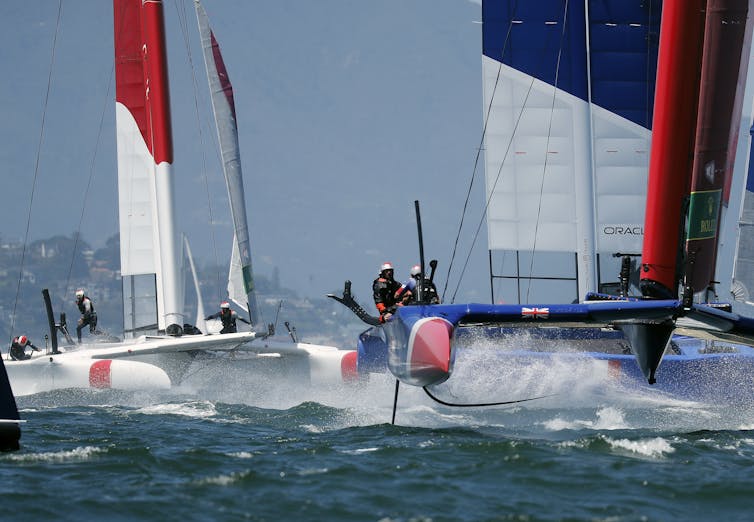
A yacht also makes waves as it pushes the water around and under the hull from the bow (front) to the stern (back) of the boat. The waves form two distinctive patterns around the yacht (one at each end), known as Kelvin Wave patterns.
These waves, which move at the same speed as the yacht, are very energetic. This creates drag on the boat known as the wave-making drag, which is responsible for around 90% of the total drag. As the yacht accelerates to faster speeds (close to the “hull speed”, explained later), these waves get higher and longer.
These two effects combine to produce a phenomenon known as “ hull speed ”, which is the fastest the boat can travel – and in conventional single-hull yachts it is very slow. A single-hull yacht of the same size as the F50 has a hull speed of around 12 mph.
However, it’s possible to reduce both the frictional and wave-making drag and overcome this hull-speed limit by building a yacht with hydrofoils . Hydrofoils are small, underwater wings. These act in the same way as an aircraft wing, creating a lift force which acts against gravity, lifting our yacht upwards so that the hull is clear of the water.

While an aircraft’s wings are very large, the high density of water compared to air means that we only need very small hydrofoils to produce a lot of the important lift force. A hydrofoil just the size of three A3 sheets of paper, when moving at just 10 mph, can produce enough lift to pick up a large person.
This significantly reduces the surface area and the volume of the boat that is underwater, which cuts the frictional drag and the wave-making drag, respectively. The combined effect is a reduction in the overall drag to a fraction of its original amount, so that the yacht is capable of sailing much faster than it could without hydrofoils.
The other innovation that helps boost the speed of racing yachts is the use of rigid sails . The power available from traditional sails to drive the boat forward is relatively small, limited by the fact that the sail’s forces have to act in equilibrium with a range of other forces, and that fabric sails do not make an ideal shape for creating power. Rigid sails, which are very similar in design to an aircraft wing, form a much more efficient shape than traditional sails, effectively giving the yacht a larger engine and more power.
As the yacht accelerates from the driving force of these sails, it experiences what is known as “ apparent wind ”. Imagine a completely calm day, with no wind. As you walk, you experience a breeze in your face at the same speed that you are walking. If there was a wind blowing too, you would feel a mixture of the real (or “true” wind) and the breeze you have generated.
The two together form the apparent wind, which can be faster than the true wind. If there is enough true wind combined with this apparent wind, then significant force and power can be generated from the sail to propel the yacht, so it can easily sail faster than the wind speed itself.
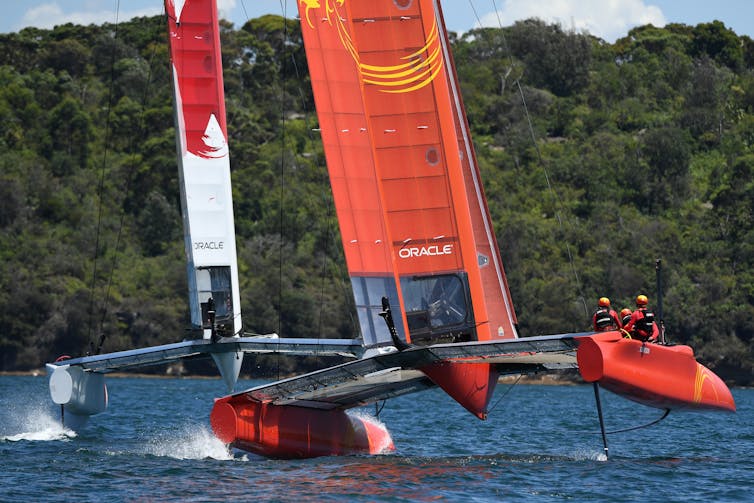
The combined effect of reducing the drag and increasing the driving power results in a yacht that is far faster than those of even a few years ago. But all of this would not be possible without one further advance: materials. In order to be able to “fly”, the yacht must have a low mass, and the hydrofoil itself must be very strong. To achieve the required mass, strength and rigidity using traditional boat-building materials such as wood or aluminium would be very difficult.
This is where modern advanced composite materials such as carbon fibre come in. Production techniques optimising weight, rigidity and strength allow the production of structures that are strong and light enough to produce incredible yachts like the F50.
The engineers who design these high-performance boats (known as naval architects ) are always looking to use new materials and science to get an optimum design. In theory, the F50 should be able to go even faster.
- Engineering
- Aerodynamics

Head of School, School of Arts & Social Sciences, Monash University Malaysia

Chief Operating Officer (COO)

Clinical Teaching Fellow

Data Manager

Director, Social Policy

How Anchors Work and All You Need to Know about Anchoring
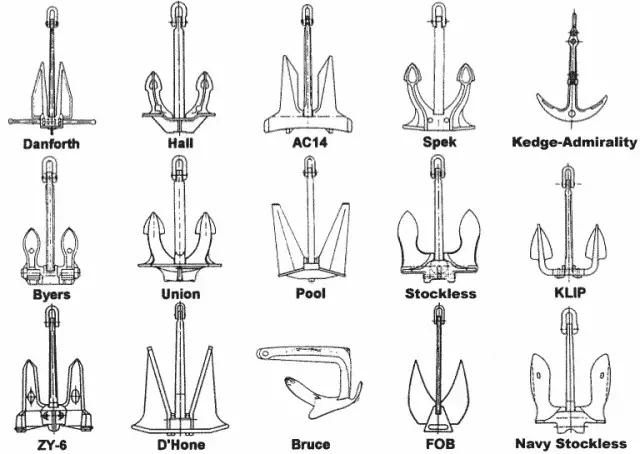
In this article, you will not only learn all the basics about anchors. You even get all the more advanced knowledge you need about how anchors work. Use the table of content if you search for an answer on a specific topic.
How Does An Anchor Hold A Ship?
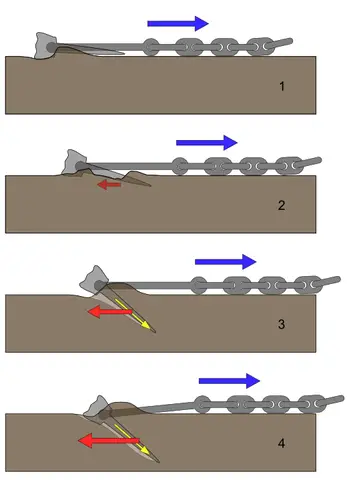
The primary force holding an anchored ship in place is the weight of the chain on the bottom of the sea.
The wind will push the boat away from the anchor and keep the chain in place.
Most anchors have flukes designed to dig into the ground. If the anchor is in the correct position, it will dig in deeper when wind or waves put pressure on the chain.
As you can see in the drawing, the anchor digs deeper into the seabed if the chain is pulled horizontally away from it.
To retrieve the anchor, the lift must be made vertically. This will happen when you pull in the chain, and the boat is directly above the anchor.
How Deep Do Ship Anchors Go?
Does a boat anchor have to touch the bottom.
Yes, all anchors rest on the seabed. An anchor is designed in such a way that it digs into the seabed and holds the boat from moving away. An anchor works together with a chain.
One exception is a drogue which I will get back to later.
How Much Chain Do You Need?
As a rule of thumb, you need a chain in the amount of 5 to 7 times the depth of the water.
How much anchor line should you use if the water is 20 feet deep? With the above-mentioned rule, you would need at least 100 feet of chain.
How Deep Do Sea Anchors Go?
As stated above, how deep an anchor goes depends on the depth of the sea combined with the length of the chain . This is why it is not possible to anchor in deep seas, you simply cannot carry that much chain.
Coasters, ferries, and other large commercial ships like dry bulkers and tankers often anchor longer from the cost than leisure boats or even at special anchor areas defined by port authorities. They have a bigger draft (deeper keel) and need a lot of space to maneuver in.
How Does A Ship Anchor Work In Deep Water?
In deep water, as I have already said, it requires a substantial amount of chain to touch the bottom. That’s why instead of an anchor, they use a large and strong underwater “parachute” also known as a storm drogue that provides a drag, which acts as a brake.
As this sea parachute is made out of fabric, it can be stored away easily. A drogue will not hold the ship in place but slow you down significantly.
In emergencies, you could use almost anything as a drogue. A plastic bag, the bag from a sail or similar.
Types of Anchors
There are generally spoken three types of modern anchor designs. The fluke anchor, the plow anchor, and the claw anchor. They all work by digging into the seabed.
Older anchor types “grabs on” rather than dig in, making them less effective than the modern models.
Both the fluke, the plow, and the claw anchor are designed with a top and a bottom. The bottom is heavier than the top, which means that it almost always turns correctly when it lands on the seabed.
Fluke Anchor
Fluke anchors are very popular on small boats and with good reason.
- It is Lightweight
- It stoves away very easily (folds up and takes only a little storage room)
- It holds well in mud or sand
On the negative side, the fluke anchor doesn’t hold very well on grassy or rocky surfaces.
Plow Anchor
Plow anchors are a safer choice if you need an all-around anchor for your boat.
Plow anchors have fixed shanks and look like a plow.
- It reset itself if the wind or current changes direction
- Holds effectively in grass, mud, and sand
On the negative side is the higher weight and need for a storage room.
Claw Anchor
A claw anchor is the cheapest type of modern anchor due to its simple design. It holds okay in any seabed but is a bit harder to handle, in my opinion. Its design is adapted from anchors used to secure oil rigs in the North Sea.
Like the plow anchor, it does not fold away and takes up a lot of storage room.
Anchor types are often named after the manufacturer who invented it, but you will find many copies with another brand name. A good example is the Bruce anchor (the claw anchor), which is a brand but also often referred to as a particular type of anchor. Bruce does not produce this type of anchor anymore, but you will find others who do.
The Weight Of The Anchor
The weight of the anchor depends on how heavy your ship is. But most important is to look at the anchor manufacturer’s suggested size.
And remember that anchor weight cannot stand alone, you also need a chain to hold the anchor. This chain acts as a shock absorber.
It is found that for small boats, one pound of anchors for every foot of boat length, is a general rule of thumb.
Suppose you have a 25’ boat, so you need a 20-25lb Bruce anchor with 50’ of 1/4 chain and 500 feet of chain to anchor in 100’ of water comfortably.
Why Do Some Ships Have 2 Anchors?
There is more than one reason why a ship would carry two anchors:
- Different anchors are needed for different seabeds
- Staying put instead of moving in circles
- For various safety reasons
Most of the time one anchor is enough to keep the ship in place but sometimes ships need to set 2 anchors to keep them in place.
Some ships carry an extra anchor because anchors can be easily lost due to various reasons like heavy wind, bad weather, strong current, etc.
Most ships have 2 anchors because with only one anchor you can move in a circle and with another, you are positioned in one place.
What Happens If An Anchor Gets Stuck?
Anchors are sometimes left behind because they get stuck, and anchors do get stuck from time to time, especially if you are not using a windlass. If this happens, the anchor will lay on the bottom of the sea until rusted and sanded into small particles of metal.
Many sailors have experienced lifting their anchor and accidentally retrieving an old anchor too.
Why Do Ships Lose Their Anchors?
Here are some of the most common reasons why ships sometimes lose their anchor:
- Inadequate securing
- Equipment failures
- Broken anchor line
- Abandoned anchor
- Environmental risk factors
Inadequate Securing
Not operating the anchor gear sufficiently is a common reason for losing the anchor. Especially not securing the end of the line or chain while focusing on other maneuvers happens very often. Having a suitable and rehearsed procedure will prevent this from happening in most cases.
Equipment Failures
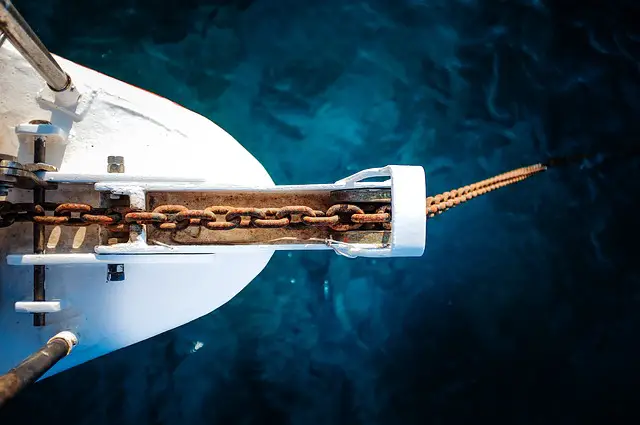
The anchor chain gets rusty, and lines lose their strength with age. It is essential to maintain all gear on a boat and to review all equipment regularly.
Rusty Anchor Line
Anchor lines are exposed if someone sails across them, and get the line in their prop. The prop can get damaged, but also the anchor line is likely to brake. That is why it is crucial to stay clear of anchored vessels. Many ships today do not use anchor lines and have only anchor chains, making anchoring more safe.
Abandoned Anchor
Ships sometimes have to leave the anchor behind, if the anchor is stuck – This happens only rarely with the modern types of anchors.
Environmental Factors
Environmental factors such as weather, the strength of the currents, and water depth are some of the most common reasons for losing anchors.
Here Is A Video That Shows Exactly How Anchors Work
Related Posts
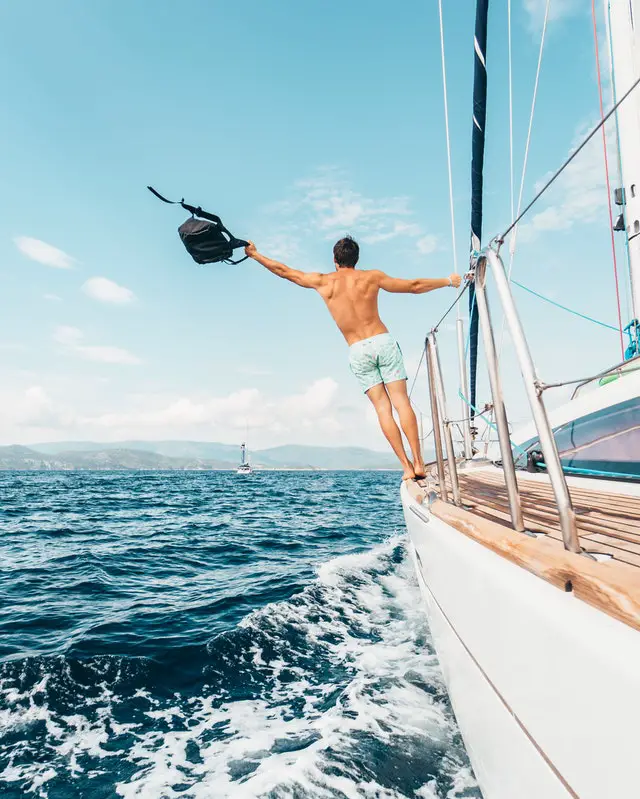
Should you own or charter a boat?
I could give you many reasons why not to buy a boat, but they would be the same reasons not to have a child. Unknown…

Which catamarans have daggerboards?
After researching catamarans we have made a list of catamarans with daggerboards. Performance means a great deal for us, so we are looking at the…

Guide to boat fiberglass
As we consider buying a larger and more comfortable boat for long voyages, I find it interesting to examine the different qualities of fiberglass and…

Silic One antifouling test
Note this post is an expression of my research and attitudes. I am neither sponsored nor otherwise influenced, other than perhaps regular advertising. Judge for…

- Autopilots: Navigating the Seas with Precision
The world of boating and sailing has seen remarkable advancements in technology, and one such innovation that has revolutionized the industry is the autopilot. Whether you're a seasoned sailor or a novice enthusiast, autopilots offer a level of convenience and precision that was once unimaginable. In this article, we will delve into the world of autopilots, explore their functionality, and understand the different types available for various marine vessels.
What Are Autopilots?
Autopilots are electronic systems that are designed to control the steering of a vessel, be it a sailboat, yacht, or any other watercraft, without the need for constant manual input from the helmsman. They use a combination of sensors, processors, and hydraulic systems to maintain the desired course and heading.
The Advantages of Autopilots
Autopilots offer several advantages, making them a valuable addition to any vessel. They not only reduce the workload on the crew but also enhance safety and navigational accuracy. Here are some key benefits:
- Reduced Fatigue: Autopilots take over the repetitive task of steering, allowing the crew to rest and stay fresh during long journeys.
- Precise Navigation: Autopilots maintain a consistent course, ensuring accurate navigation even in challenging conditions.
- Improved Fuel Efficiency: Autopilots optimize the vessel's route, potentially saving on fuel costs.
- Increased Safety: They reduce the risk of human error, a common cause of accidents at sea.
Types of Autopilots
Raymarine autopilot.
Raymarine autopilots are renowned for their cutting-edge technology. They offer exceptional control and reliability, making them a popular choice among sailors and boaters. The Raymarine autopilot system integrates seamlessly with various chartplotters and navigation equipment.
Tiller Pilots
Tiller pilots are a type of autopilot designed for smaller vessels and sailboats. They are compact and efficient, offering excellent control of the tiller without the need for a dedicated steering wheel.
Boat Autopilot
Boat autopilots are a broad category that encompasses autopilot systems designed for various types of boats, from fishing boats to luxury yachts. These systems come in various sizes and configurations to suit different vessels.
Autopilot Meaning and Functionality
An autopilot's primary function is to maintain a predefined course and heading, relieving the helmsman from continuous manual steering. It achieves this by constantly analyzing data from sensors such as GPS, compasses, and wind gauges.
Autopilots in Yachts
Yacht wheel autopilots.
Yacht wheel autopilots are designed for larger vessels with a conventional steering wheel. They provide precise control, allowing captains to navigate with ease.
Autopilot for Sailing Yachts
Sailing yachts often benefit from autopilots, which can adjust sails and maintain course even when sailing close to the wind. This ensures a smoother and more enjoyable sailing experience.
Sailing Yacht A Cost
"Sailing Yacht A" is an example of a luxury sailing yacht equipped with advanced autopilot systems. While the cost of such systems can be substantial, the convenience and safety they offer are invaluable.
Read our top notch articles on topics such as sailing, sailing tips and destinations in our Magazine.
Autopilots for Tiller Steering
Autopilot tiller systems.
Tiller autopilots are popular among smaller boats and sailboats. They connect directly to the tiller and can maintain course and heading accurately.
B&G Autopilot
B&G autopilots are trusted in the sailing community for their performance and reliability. These systems are designed for a wide range of sailing vessels.
Raymarine Wheel Pilot
Raymarine offers wheel pilot systems for vessels with wheel steering. These autopilots are known for their precision and ease of use.
How Autopilot Systems Work
Autopilots use a combination of sensors to gather data about the vessel's position and heading. The processor then calculates the necessary steering adjustments and sends commands to the hydraulic system or tiller to maintain the desired course.
The Benefits of Marine Autopilots
Marine autopilots go beyond convenience. They play a crucial role in long-distance cruising, racing, and offshore passages. Their benefits include reduced fatigue, enhanced safety, and more efficient navigation.
Autohelm Autopilot for Sailboats
Autohelm offers a range of autopilot systems designed specifically for sailboats. These systems are known for their robustness and adaptability to different sailing conditions.
Choosing the Right Autopilot System
Selecting the right autopilot system depends on factors like the type of vessel, budget, and specific requirements. It's essential to research and consult with experts to make an informed choice.
Maintaining Your Autopilot
Proper maintenance is crucial to ensure your autopilot system functions optimally. Regular checks, software updates, and hydraulic system inspections are essential for long-term reliability.
In the world of boating and sailing, autopilots have transformed the way vessels are navigated. Their ability to provide precise steering, reduce fatigue, and enhance safety makes them an invaluable addition to any boat. Whether you're cruising on a yacht or racing on a sailboat, autopilots offer a smoother and more enjoyable journey. Make the smart choice and invest in this technology to take your maritime adventures to the next level.
So what are you waiting for? Take a look at our range of charter boats and head to some of our favourite
sailing destinations .
Yachting Monthly
- Digital edition

How it works: Marine gearboxes and clutches
- Toby Heppell
- July 12, 2023
Marine gearboxes and clutches are an essential component of your yacht's engine, but do you know how they work and how to fix them?

The gearbox on a marine diesel engine has three purposes: to reduce the maximum speed at which the propeller rotates; to enable both forward and astern rotation of the propeller; and to enable the propeller to remain stationary when the engine is running. Unlike a car gearbox, there is usually only one forward gear and the clutch is contained within the gearbox.
Because modern engines run at too high a speed for normal operation of the propeller, gearing reduction is required. The reduction gear ratio is usually between 2:1 and 3:1, with different manufacturers often using differing ratios.
Gear selector
The input shaft to the gearbox is separate from the output shaft.
It can drive the output shaft by either of two sets of gears to give forward or astern propulsion, with the output shaft connected to the appropriate set of gears using one of two separate clutches. It is these clutches that are operated by the gear selector rather than the gears themselves, as is the case in a car. In other words, one clutch for ahead, one for astern. And never both at the same time.
Two-Shaft Gearbox
The simplest and most compact gearbox just has an input shaft and an output shaft. The input shaft drives the forward gear directly and the reverse gear via an idler gear. A cone clutch or plate clutches are moved along the freely rotating output shaft from the centre, neutral position, to link either the forward or reverse gears to the output shaft. The clutch mechanism can be designed so that, as the clutch engages, more force is provided automatically to ensure full engagement.
Layshaft Gearbox
The principle of operation of the other most common gearbox, the layshaft, is similar to the two-shaft box, but a separate shaft – the layshaft – is used. One clutch is mounted on the input shaft and the other on the layshaft. The output shaft rotates in the same direction as the engine in forward gear. These gearboxes normally use hydraulic actuation of the clutches.
Maintenance
Other than checking the gearbox oil level weekly, there’s usually no other routine maintenance required. Gearboxes may use the same grade of oil as the engine, a different grade, or automatic transmission oil (ATF), but it’s vital to use the oil specified in the handbook. Gear oil is thicker than engine oil.

How Do Land Yachts Work? (Discover the World of Land Yachting)

Have you ever dreamed of sailing through the air, feeling the rush of wind in your hair? Well, you don’t need the ocean to achieve this feeling – you can experience the thrill and freedom of land yachting! A land yacht is a lightweight vehicle that’s propelled by wind and steered with a sail, allowing you to glide across land with ease.
In this article, we’ll explore the world of land yachting – from the design of a land yacht to the safety tips you should keep in mind.
So get ready to experience an adventure like no other – let’s discover how land yachts work !.
Table of Contents
Short Answer
Land yachts are a type of sail-powered vehicle that is designed to move over land, usually on a flat surface.
They use a sail to catch the wind and propel the vehicle forward, similar to a sailboat.
The driver of a land yacht uses the rudder to steer, and can also adjust the sail and the height of the mast to adjust the speed.
Land yachts can reach high speeds, making them popular for recreational use.
What is a Land Yacht?
A land yacht is a type of sailboat designed to traverse the open terrain of land rather than the ocean or other bodies of water.
These yachts are typically equipped with a three-wheeled frame, a large sail, and a rotating mast that can be adjusted to catch the wind.
The wheels are used to steer the yacht, providing an exciting and adventurous ride that allows people to explore open areas such as deserts and beaches.
The land yachts design is tailored to harness the power of the wind and its ability to propel the yacht forward.
The position of the sail and the angle of the mast can be adjusted to maximize the yachts speed, while the wheels are able to provide directional control in order to steer the yacht.
Land yachts are a unique and fun way to explore open areas, and have become increasingly popular in recent years.
They provide an exhilarating experience, and can be a great way to experience the outdoors in a new and exciting way.
Land yachting is becoming a popular activity for those looking for an adrenaline-filled adventure, and can be a great way to explore the world around you.
The Design of a Land Yacht

Land yachts are designed with a frame that is usually made from aluminum or steel, and can be built in a variety of sizes to accommodate a single rider or a larger group.
The three-wheeled frame is designed to allow for a stable ride and easy maneuverability, and the wheels are typically made from a lightweight material such as plastic or rubber.
The sail is mounted on a rotating mast, which can be adjusted to catch the wind effectively and propel the yacht forward.
The mast is also adjustable to allow for the changing direction of the wind, and the steering of the yacht is done via the wheels.
In addition to the frame and sail, land yachts come with rigging, which is the set of ropes and pulleys that attach the sail to the frame and mast.
This rigging is adjustable and can be adjusted to capture the wind more effectively, allowing for greater speed and control.
The rigging also includes a brake system that allows the rider to slow down or stop the yacht with ease.
Land yachts also come in a variety of styles and designs, from traditional sailboats to modern, aerodynamic designs.
The frame and sail can also be customized to suit the riders needs, with color and design choices available to make the yacht look unique and stylish.
Overall, land yachts are designed to provide an exciting and adventurous ride on land, allowing riders to explore open areas such as deserts or beaches.
With the adjustable rigging and frame, the yacht can be tailored to the riders needs, allowing for a safe and comfortable ride.
How a Land Yacht is Propelled
The key to land yachts is how they are propelled.
It uses the power of the wind to move the vehicle, much like a sailboat does in the water.
This is done by mounting a large sail to a rotating mast that can be adjusted to catch the wind.
The wind then fills the sail, providing thrust and pushing the yacht forward.
The sail can be adjusted to catch the wind coming from different directions, allowing the land yacht to change direction and navigate around obstacles.
The wheels of the land yacht are used to steer it, allowing it to turn in different directions.
The size of the sail is important when it comes to propelling the land yacht.
The bigger the sail, the more wind it can catch, and the faster the vehicle can go.
The size of the sail can be adjusted to suit the conditions of the environment, allowing the land yacht to travel at a comfortable speed.
It is also possible to adjust the angle of the sail to make it more efficient, allowing the yacht to make the most of the available wind.
In addition to the sail, some land yachts also have a motorized propeller that can be used to help propel the vehicle.
This can be helpful if there is not enough wind to fill the sail, or if the terrain is too challenging for the yacht to travel through.
The motorized propeller can also be used to help the yacht travel up steep hills or through shallow waters.
Land yachts are an exciting way to explore open areas such as deserts and beaches.
They provide a unique and thrilling ride, with the rider able to take advantage of the wind to travel quickly and navigate around obstacles.
With a little practice, anyone can master the art of land yachting and enjoy the adventure of exploring new places.
Steering a Land Yacht

Steering a land yacht is a unique experience that requires skill and practice.
Unlike a boat that uses a rudder to control its direction, a land yacht uses its wheels to steer.
The wheels are connected to the sail by a complicated system of ropes and pulleys.
By adjusting the angle of the sail in relation to the wind, the yacht will turn left or right depending on the direction of the wind.
Additionally, the wheels can be used to turn the yacht in the same manner as a car.
In order to steer a land yacht, the driver must be familiar with the principles of sailing and the forces that act upon the sail.
The driver must be aware of the wind direction and the angle of the sail relative to the wind.
The driver must also be aware of the terrain in order to choose the best line for the yacht to travel.
The driver must also pay close attention to the rope and pulley system connected to the wheels and the sail.
By adjusting the ropes, the driver can make small adjustments to the sail in order to optimize the yachts speed and direction.
This can be a difficult task, as the driver must maintain a delicate balance between speed, direction, and terrain.
The most important part of steering a land yacht is practice.
With enough practice, a driver can master the art of sailing and be able to maneuver their yacht with ease.
With practice, a driver can become an expert at land yachting and enjoy the thrill of exploring open areas with the wind at their back.
The Benefits of Land Yachting
Land yachting is an exciting and adventurous way to explore open areas such as deserts and beaches.
It offers a unique experience that is not found in traditional sailing, allowing you to explore new places and have a thrilling ride.
Land yachting has many benefits that make it a great activity for those who want to try something new and exciting.
First, land yachting is a much simpler form of sailing than traditional sailing.
It requires less skill to learn and operate, and is generally easier to maneuver.
This makes it a great option for anyone looking to take up a new hobby or just enjoy some time on the water.
Second, land yachting is often much less expensive than traditional sailing.
Since land yachts are designed to be used on land, they often require less maintenance and upkeep than traditional sailing vessels.
This makes them more affordable, allowing more people to enjoy the experience.
Third, land yachting is a great way to explore and experience new places.
Since land yachts are designed to be used on land, they are able to access places that traditional sailing vessels cannot.
This makes it a great way to explore areas that may otherwise be inaccessible.
Finally, land yachting is a great way to get exercise.
While sailing, you will be active and moving, which can help to keep your heart healthy and your muscles strong.
Additionally, being in the sun can help to give you a healthy dose of Vitamin D.
Overall, land yachting is an exciting and adventurous way to explore open areas such as deserts and beaches.
With its simplicity, affordability, and ability to access remote areas, land yachting is an appealing activity that anyone can enjoy.
Where to Go Land Yachting

Land yachting can be an incredibly exciting and adventurous experience.
Whether you’re looking for a thrilling day trip or a weekend getaway, land yachting is a great way to explore the great outdoors and take in the sights and sounds of nature.
Land yachting is an activity that can be enjoyed on a variety of terrains, from beaches and deserts to open fields and more.
For those looking to explore the great outdoors, land yachting is a great way to get out and about and explore the world in a unique and fun way.
Beaches and deserts are great places to try out land yachting, since they provide plenty of open space and the wind can be used to propel the yacht.
Open fields, such as large grassy areas or fields with no trees, can also be great spots to go land yachting.
Another great place to try out land yachting is on a lake.
Lakes provide plenty of open area for the wind to catch the sail and propel the yacht, and it’s a great way to explore the natural beauty of the area.
Lakes are also less likely to have obstacles such as trees or rocks that can get in the way, which makes it a great option for those looking for a safe and enjoyable experience.
No matter where you choose to go land yachting, it’s important to make sure you have the right equipment and supplies.
Make sure you have the right size sail for the wind conditions in the area, as well as a helmet and protective clothing.
It’s also important to be aware of the terrain and make sure there are no obstacles that could get in the way.
Land yachting is a great way to explore the outdoors and take in the sights and sounds of nature.
With the right safety precautions and equipment, land yachting can be an exciting and unique experience that can be enjoyed by the whole family.
So why not give it a try? It’s sure to be a great adventure!.
Safety Tips for Land Yachting
Land yachting is a thrilling and adventurous way to explore open areas such as deserts and beaches, but it is important to remember that safety should always come first.
Before you set out on your land yachting expedition, there are a few key safety tips to remember: 1.
Wear protective clothing Land yachting can be a fast and bumpy ride, so make sure to dress appropriately.
Wear a sturdy pair of shoes, long pants, and a long-sleeved shirt to protect yourself from any debris that may be kicked up.
Wear a helmet Land yachting can be a dangerous activity, and you should always be prepared for the worst.
Wear a helmet to protect your head in case of an accident.
Check the weather Make sure to check the weather forecast before you set out on your journey.
Strong winds can make land yachting dangerous, so make sure the conditions are suitable for your activity.
Check your equipment Before you go, make sure to check that all your equipment is in good working order.
Check your sail and mast to make sure they are properly rigged and adjusted, and make sure your wheels are secure and in good condition.
Stay aware While land yachting, be aware of your surroundings at all times.
Pay attention to any changes in the wind direction, look out for any obstacles, and be ready to adjust your course if necessary.
By following these safety tips, you can make sure that you have a safe and enjoyable land yachting experience.
Remember to always use caution and common sense, and you’ll be sure to have a great time.
Final Thoughts
Land yachting is an exciting, adventurous way to explore the world! With its unique design, a land yacht is propelled by the wind and steered by its wheels, making it a thrilling ride.
With the right safety precautions, land yachting can be an unforgettable experience.
So what are you waiting for? Get out there and explore the world of land yachting today!.
James Frami
At the age of 15, he and four other friends from his neighborhood constructed their first boat. He has been sailing for almost 30 years and has a wealth of knowledge that he wants to share with others.
Recent Posts
When Was Banana Boat Song Released? (HISTORICAL INSIGHTS)
The "Banana Boat Song" was released in 1956 by Harry Belafonte. This calypso-style song, also known as "Day-O," became a huge hit and remains popular to this day for its catchy tune and upbeat...
How to Make Banana Boat Smoothie King? (DELICIOUS RECIPE REVEALED)
To make a Banana Boat Smoothie King smoothie at home, start by gathering the ingredients: a ripe banana, peanut butter, chocolate protein powder, almond milk, and ice. Blend the banana, a scoop of...
- EXPLORE Random Article
How to Work on a Yacht
Last Updated: June 4, 2023 References
This article was co-authored by wikiHow Staff . Our trained team of editors and researchers validate articles for accuracy and comprehensiveness. wikiHow's Content Management Team carefully monitors the work from our editorial staff to ensure that each article is backed by trusted research and meets our high quality standards. There are 8 references cited in this article, which can be found at the bottom of the page. This article has been viewed 3,279 times.
Working on a yacht is a unique, fun, and potentially lucrative way to earn a living. While it can be intimidating and challenging to get a job on a yacht, having the opportunity to work while traveling can make it well worth it. To begin working on a yacht, you can get an entry-level job that requires little to no prior yachting experience. Once you are more experienced in the yacht business, you will be able to work on a yacht in a more advanced and specialized role.

Getting an Entry-Level Job on a Yacht

- Junior deckhands generally have a good work ethic, positive attitude, ability to learn on the job and follow directions, a professional appearance, and work well with a team. [2] X Research source
- Junior deckhands are responsible for cleaning, polishing, and waxing the yacht, assisting the bosun and first mate with maintenance, and helping with general yacht operations, including line handling, navigation, passenger safety, and water sports. [3] X Research source
- Junior deckhands make approximately $27,000 per year. [4] X Research source

- While not always a requirement, having a watersports certification, fishing knowledge or expertise, and/or carpentry skills can help you get a job as a deckhand on a yacht. Having one or more of these skills may also help you earn more money. [7] X Research source
- Much of a deckhand’s work is performed on the outside of the boat. Therefore, as a deckhand, you would be doing a lot of manual labor outside. This can be helpful to keep in mind when deciding if working as a deckhand is right for you.
- Deckhands usually make between $27,000 and $55,000 per year.

- Boat attendants are responsible for maintaining the cleanliness of the ship’s interior, helping with guest management and entertainment, and assisting the crew in maintaining the safety of everyone on board. [9] X Research source
- Successful boat attendants are high-energy and good entertainers, exhibit proper hospitality etiquette while on the job, and are committed to maintaining yacht cleanliness. [10] X Research source
- Entry-level ship attendants usually make around $40,000 per year, while more experienced workers can make up to $100,000 per year on a large luxury yacht. [11] X Research source

- One of the keys to working as a chef on board a yacht is the ability to get creative with your ingredients. Once you leave the dock, you will likely only have access to the ingredients that you have on hand.
- When considering working as a chef on a yacht, it can be helpful to take into consideration the size of the yacht, the number of people typically on board, and the conditions in the kitchen. As the chef, you will be responsible for making most (if not all) the food for everyone on board, meaning that you may be spending most of your time in the kitchen.
- If you have experience or professional training as a chef, you can make between $52,000 and $100,000 per year on a yacht, depending on your level of training and the size of the yacht. If you do not have any prior experience, you can make between $36,000 and $75,000 per year as a chef on a yacht. [12] X Research source

- Crewnetwork.com and luxyachts.com are both popular yacht crew online agencies.

- If you are working on a yacht abroad, you may need to acquire a work visa. Contact your yachting company or owner to see if this applies.
Working in an Advanced Position

- Bosuns often have a specific area of expertise that helps them land the job and makes them a more valuable member of the crew, such as advanced woodworking, varnishing, rigging, or watersport expertise.
- Bosuns generally make between $36,000 and $100,000 per year.

- On smaller yachts, there is usually just one mate, called the first mate. On larger yachts, however, there may also be a second mate and, possibly, even a third mate. The second and third mates also have extensive experience, yet generally a bit less than the first mate.
- In the event of an emergency, or if the captain needs to take a leave, the mate is responsible for taking over the captain’s duties. As a result, mates need to have any required licenses or certifications for their specific type of yacht.
- Mates on a yacht typically make at least $48,000 and up to $100,000 per year. [14] X Research source

- Yacht captains must have a high school diploma or GED.
- To be a yacht captain, you will need to take a captain’s license course and pass the licensing exam.
- The captain of a yacht typically makes a minimum of $65,000 per year. Captains can make well over $200,000 per year working on a larger yacht. [16] X Research source

- Most engineering positions are available on larger yachts called superyachts. While smaller yachts will hire a yachting engineer for maintenance, they do not usually have a permanent engineer that works on-board. [18] X Research source
Expert Q&A
- Larger luxury yachts may also hire beauticians, pursers, and/or managers to provide luxury services to their clientele. [19] X Research source Thanks Helpful 0 Not Helpful 0
- You can find job postings for positions on yachts on general job search engines, such as Indeed and ZipRecruiter, as well as specialized yachting job search engines, such as yotspot.com and yaCrew.com. Thanks Helpful 0 Not Helpful 0
- When looking for a job on a yacht, it can be helpful for you to already have completed your Standards of Training, Certification, and Watchkeeping (STCW) certification course. This certification is not always required to work on a yacht, but it can help make you a more desirable candidate. Thanks Helpful 0 Not Helpful 0
You Might Also Like

- ↑ https://www.luxyachts.com/crewpositions/jrdeckhand
- ↑ https://www.luxyachts.com/crewpositions/deckhand
- ↑ http://www.workonayacht.com/index.php/official-yacht-stewardess-job-descriptions-salaries/
- ↑ https://www.crewfinders.com/yachtcrewsalaries.shtml
- ↑ https://www.luxyachts.com/crewpositions/mate
- ↑ https://www.luxyachts.com/crewpositions/captain
- ↑ https://www.crewnetwork.com/Yachting-Jobs/engineer.aspx
- ↑ https://whereintheworldisnina.com/working-on-superyachts/
About this article

Did this article help you?

- About wikiHow
- Terms of Use
- Privacy Policy
- Do Not Sell or Share My Info
- Not Selling Info
Working On Yachts
There are currently over 15,000 yachts in the world large enough to require professional, qualified yacht crew and as a result this industry is growing rapidly each year.
A career in yachting can be rewarding, exciting and a wonderful opportunity to travel the world and explore new horizons!
Wherever there is water, you have the potential to go. Traditionally the yachting industry in the Mediterranean runs from April until September and from November to April in the States & Caribbean. Having said that, the possibilities are endless with many yachts circumnavigating the world.
Yachting is an eye opening, ultimately fun industry that demands hard work, perfection and attention to detail. We work with yacht crew every day and have a deep insight into what new crew should do to make the most of their career. Here are our top ten tips for starting out.
You cannot work on board a luxury yacht without getting your basic qualifications first. Bluewater offers a full range of crew training courses for those just starting in the industry:
- STCW 95 Basic Training (Europe) 5 Day Course
- Powerboat Level II 2 Day Course
- Interior Introduction 3 Day Course
- AEC 1 5 Day Course
We have a sample copy and lots of relevant advice on creating your first yachting CV within our 'Your CV' section.
Certain times of year are more favourable for new crew looking to join the industry. If you are going to Antibes or Palma, we advise end of March/April. Fort Lauderdale is different in that it is sunny most of the year, however there is a peak recruitment season around November each year.
In every yachting hub you will find english speaking bars and cafes filled with yacht crew. Make sure you go and explore to build your network within yachting. Although global, it is a small industry so make sure to present yourself professionally.
Finding your first position in yachting is the hardest. Make sure you are dock walking, looking for day work opportunities and handing out your CV. You may find that one day's work leads to a permanent role or other job interviews.
Read websites, follow yachting news, learn from other crew who were in your 'deck shoes' a few years ago. Good examples of yachting websites & magazines are:
- Bluewater bluewateryachting.com
- Dockwalk dockwalk.com
- The Crew Report thecrewreport.com
- The Triton thetriton.com
Apply for jobs, manage your course bookings and sign up for events.
You can buy pay as you go SIM cards either in newsagents or specialised telephone shops around the Mediterranean. This will help to save you money when job hunting!
Captains check Facebook and Twitter pages before interviews. Make sure any public images of you are professional and will not reduce your chances of employment. Once employed be sure to avoid any posts about your yachts, current location and inappropriate images.
A smart, professional appearance will win over shorts and a beach top.
The most important aspect when you are looking for work is to make sure your CV is up to date, well written and includes any relevant experience that you might have.
It is best to emphasize any hospitality experience or customer service skills you may have had, such as waitressing, hostessing, silver service, bartending, cooking, nanny/au-pairing, babysitting, flower arranging, cleaning and/or laundry experience.
Should you wish to join the engineering department, make sure you include all mechanical experience and qualifications, including all work done in refrigeration, air conditioning, work with engines, and any electrical work, electronics or AV/IT.
The most important aspect to include is any recreational sailing experience you may have had. If you are also qualified or experienced in woodwork or carpentry, have painting, polishing, varnishing know-how, then that is also great. In addition any diving, sailing, fishing, any water sports background are all fantastic skills that are easily transferable.
We deal with a great multitude of chef positions, ranging from crew chef to head chef. Most positions will require some form of culinary training, however some crew succeed in entering this department through the stew/cook route on a smaller yacht.
When filling in your online profile with us, make sure to only select positions that you are qualified to do onboard. Selecting more than 3-4 positions on your profile can confuse potential employers and effect our search results.
Your CV should be no more than two sides of A4, including your photograph (in colour, face on, without sunglasses).
Your CV should be in a word format to ensure it can be opened easily by all employers.
List all recent contact information, references and work history.
Including a personal statement, along with a clear objective can help distinguish you from other candidates and helps prospective employers grasp your long term goals.
Don't give employers an excuse to dismiss your CV, review and spell check it!
Salary Guidelines
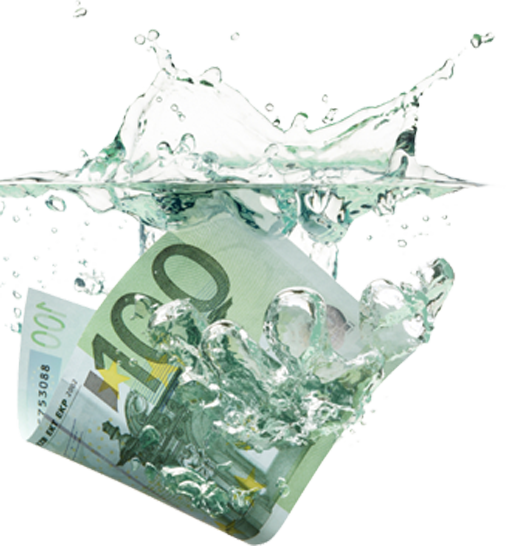
Knowledge is power and the more you research, the more informed & on the ball you will be.
Make sure you have a printed copy of your CV with you and always arrive early and dressed in a smart way. Research the yacht, make yourself prepared & don't be afraid to ask questions.
The key to getting your first job is to network! Always carry a copy of your CV with you.
Remember the industry is a tight, professional network therefore it is crucial to communicate with others, walk the docks, distribute your CV and register with crew agencies. Bluewater is one of the longest-established crew agents - we have been finding people yacht jobs since 1991!
Keep the agencies up to date! Always make sure your profile has the correct location and contact numbers for you so we can get hold of you when we have the perfect role for you.
Your profile is essential to us finding you work, both now and in the future. We rely on the information you input to match you to the right jobs, so please make sure it is up to date and at least 85% complete. We receive thousands of vacancies each year, and search our database for the best candidates for each one... You will hear from us more often if you are checking in regularly! Once you find work you can set your profile to 'Not Available'.
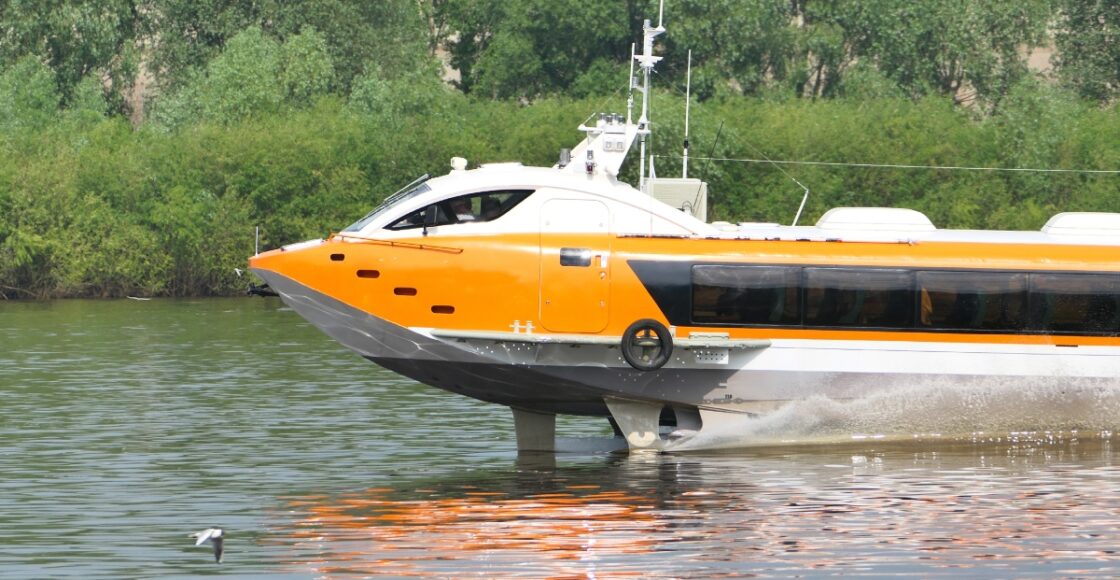
It’s a Boat. It’s a Plane. It’s a Hydrofoil Boat: What Is It, How It Works, & Why Buy One!

Table of Contents
Last Updated on June 5, 2024 by Boatsetter Team
We’ve created this helpful guide to introduce new and experienced boaters to the facts and features of hydrofoil boats. We’ll delve into the practical aspects and explore the advantages and considerations they bring. Whether you’re drawn to the efficiency of the design or the promise of smoother rides, hydrofoil boats might be just the subtle yet impactful change you’re looking for in your boating ventures. Post summary:
- What are hydrofoil boats & the works
- Why choose a hydrofoil boat
- What to consider before buying
Rent. List. Share—Only at Boatsetter
What are hydrofoil boats & the works
A hydrofoil boat is a watercraft equipped with wing-like structures mounted beneath the hull . The hydrofoils generate lift as the boat accelerates, causing the hull to rise above the water’s surface.
Decreasing the hull’s contact area with the water helps to reduce hydrodynamic drag and wave resistance and increases fuel efficiency. Vessels can achieve higher speeds for longer distances, making hydrofoil boats ideal for applications like ferry services and long-distance travel.
The concept of the hydrofoil boat emerged in the early twentieth century. Today, this innovation offers a thrilling option for boaters seeking a unique, efficient, and more environmentally friendly boating experience. Pro tip: On Boatsetter , you can browse through 20,000 different makes & models of boats!
Why choose a hydrofoil boat
Three words: Speed, stability, and maneuverability!
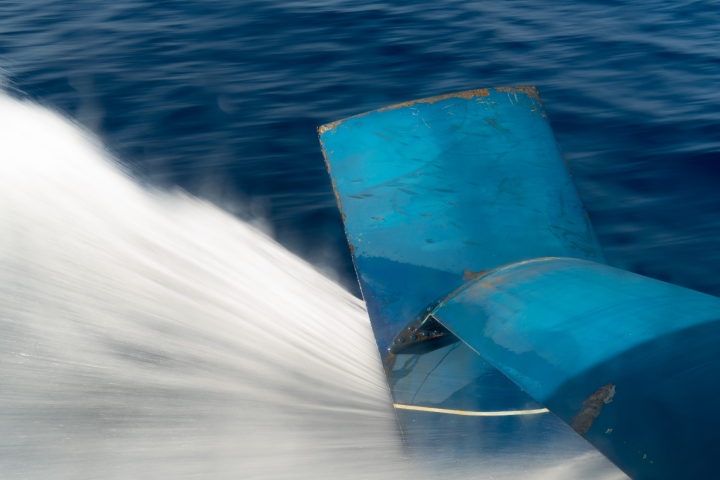
1. Speed
The lift generated by hydrofoils allows these vessels to glide effortlessly, offering a thrilling experience for adrenaline-seeking boaters. Speed comes with improved fuel efficiency, which makes hydrofoil boats an eco-friendly option as well.
2. Stability
Whether you’re facing calm waters or challenging sea conditions, lifting above the water surface minimizes the impact of waves on hydrofoil boats. This provides a smoother ride and enhanced stability, which makes for a more comfortable and enjoyable voyage.
3. Maneuverability
Hydrofoil boats excel in maneuverability, offering a dynamic and agile experience on the water. Lifting enables quick and precise movements, making hydrofoil boats a preferred choice for boaters who appreciate responsive navigation.
What to consider when buying a hydrofoil boat
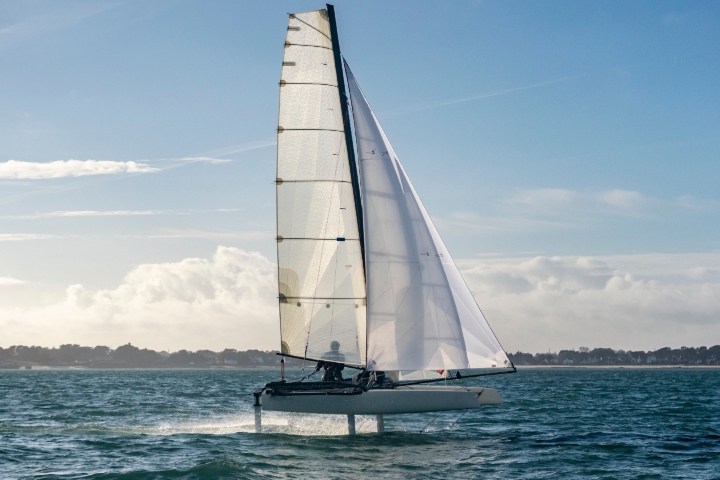
Complex design = Complex maintenance
The intricate design of hydrofoil boats, including the hydrofoils themselves and control systems, demands careful maintenance and technical expertise . Boaters should be prepared for higher maintenance costs and the need for specialized knowledge to keep the vessel in premium condition.
Weather sensitivity
While hydrofoil boats perform admirably in various water conditions, they can be sensitive to extreme weather, especially strong winds. The hulls of traditional vessels remain fully submerged in water, which means they face more resistance on the water during strong winds. Hydrofoil boats are lifted out of the water, which means strong winds pose more of a threat to the boat’s stability and control. So, when you set sail in a hydrofoil boat you’ll want to be sure to carefully consider the weather conditions.
Initial cost investment
The advanced technology, specialized materials, and intricate design that contribute to hydrofoil boats’ uniqueness also add to their price tag. Hydrofoil boats often have a higher initial cost compared to traditional vessels, so you should be sure to weigh the upfront investment against the long-term benefits. Pro tip: Trying to figure out budgeting to buy a boat? Read How to Rent Out Your Boat? (How Much Can You Actually Make?)
Ready to try hydrofoil boating?
Hydrofoil boats offer an exhilarating experience for boaters seeking speed, efficiency, and stability on the water. Whether you’re looking for a quick thrill or want a more fuel-efficient option for your long-distance trips, we recommend giving hydrofoil boats a chance.
Boatsetter boat rentals provide the perfect solution for those eager to try hydrofoil boating without committing to ownership. Seize the opportunity to experience the excitement firsthand and ensure your next adventure is not just a boat ride, but a hydrofoil-powered journey.
For more information, click here !
About us
Boatsetter is the go-to app for boat rentals and on-water experiences. Whatever the adventure, we’ve got a boat for that—Set sail , start the party , go yachting , make your trophy catch , and hone your watersports skills! Download the Boatsetter app ( App Store | Google Play ). Make sure to follow @boatsetter on Instagram, and tag us in all your boat day pictures for the chance to be featured.

Boatsetter empowers people to explore with confidence by showing them a world of possibility on the water. Rent a boat, list your boat, or become a Boatsetter captain today.
Browse by experience

Explore articles

Understanding the Nautical Flags, Sailing Flags, & the Nautical Alphabet

5 Best Lake Near Los Angeles, CA

Experience The Chicago Air and Water Show From A New Perspective This Year

Pumpkin Patches, Fall Foliage, & On-Water Scenery: The 12 Best US Cities for Fall Travel
How Does a Yacht Autopilot Work: An In-Depth Explanation
The vast expanse of the open sea, the gentle sway of the waves, and the freedom to explore distant horizons – these are just a few of the enchanting aspects of boating that draw enthusiasts to the water. Yet, amidst the allure of the maritime world, sailors have long grappled with the demanding task of steering their vessels, especially during extended journeys. Enter the remarkable innovation of yacht autopilots – a technological marvel that has revolutionized modern boating.
At the heart of every yacht autopilot lies the promise of convenience and safety. With these ingenious systems in place, the helmsperson can now relinquish the constant duty of steering, allowing them to divert their attention to other vital aspects of navigation and the welfare of the vessel and crew. As we embark on this journey, we will delve into the inner workings of yacht autopilots, illuminating the cutting-edge technology and mechanisms that make them such invaluable assets to sailors and adventurers alike. Whether you are an experienced yachtsman seeking to deepen your understanding or a curious novice eager to explore the wonders of modern boating, this article is your comprehensive guide to unlocking the secrets of yacht autopilots. So, let us set sail on this captivating voyage of knowledge and exploration.
Understanding the Basic Principle

At the core of yacht autopilots lies a brilliant fusion of electronics and control systems, all designed to accomplish one fundamental goal – maintaining the boat’s desired course without constant manual intervention. The principle behind yacht autopilots is grounded in sophisticated technology and precise mechanisms that work seamlessly together.
Electronic Sensors:
Yacht autopilots rely on a series of electronic sensors to monitor the boat’s heading and movement. The primary sensor is typically a compass, which provides real-time information on the boat’s current direction. Some modern autopilots also incorporate advanced sensors such as gyroscopes and GPS (Global Positioning System) receivers, enhancing their accuracy and responsiveness.
Control Systems:
The control system is the brain of the yacht autopilot, analyzing data from the electronic sensors and making adjustments to keep the boat on the intended course. It processes the information received from the compass and other sensors, comparing it to the desired course set by the helmsperson. Based on this analysis, the control system calculates the necessary steering corrections.
Key Components:
A yacht autopilot comprises several essential components, each playing a critical role in the system’s operation. The compass serves as the primary reference for the boat’s heading, feeding data to the control unit. The control unit is the central processor that interprets the compass data and other sensor inputs, determining the required course corrections. Finally, actuators are responsible for physically moving the boat’s steering mechanism to execute the corrections set by the control unit.
Through this intricate interplay of electronic sensors, control systems, compasses, and actuators, yacht autopilots autonomously maintain the boat’s intended course. As we journey deeper into the mechanics of yacht autopilots, we will uncover the fascinating nuances that make these systems so indispensable in modern boating.
Input and Data Gathering in Yacht Autopilot Systems
In the realm of yacht autopilots, data gathering is paramount to ensure precise and reliable navigation. These sophisticated systems rely on a multitude of input sources to understand the boat’s current position, heading, and environmental conditions. Let’s explore the critical role of input and data gathering in yacht autopilot systems:
- GPS (Global Positioning System): GPS is a cornerstone of modern yacht autopilots, providing accurate and continuous information about the boat’s latitude, longitude, and speed over the ground. This data is vital for determining the boat’s position relative to the intended course and making necessary corrections to stay on track.
- Compass: As mentioned earlier, the compass serves as the primary sensor for the boat’s heading. It provides real-time data to the autopilot’s control unit, ensuring the boat stays on the desired course, regardless of wind and current variations.
- Wind Sensors: Yacht autopilots often integrate wind sensors to account for wind direction and strength. This data helps the autopilot adjust the boat’s course to maintain optimal sailing angles relative to the wind, enhancing both performance and efficiency.
- Depth Sensors: In some cases, autopilots utilize depth sensors, especially in shallow or hazardous waters. By monitoring the depth beneath the boat, the autopilot can navigate safely, avoiding potential grounding or hazards.
Accurate and Reliable Data: The precision and effectiveness of yacht autopilots heavily depend on the accuracy and reliability of the input data they receive. Inaccurate or corrupted data can lead to course deviations, affecting the boat’s performance and safety. Therefore, manufacturers emphasize the importance of high-quality sensors and robust data processing algorithms to ensure optimal performance.
By harnessing data from multiple sources such as GPS, compass, wind sensors, and depth sensors, yacht autopilots create a comprehensive and real-time understanding of the boat’s position and environmental conditions. This wealth of information empowers the autopilot to make precise adjustments, allowing sailors to navigate confidently and focus on other aspects of their seafaring journey. As we venture further, we will explore the mechanisms that transform this data into fluid and graceful course corrections, ushering sailors into a new era of boating convenience and ease.
Course Calculations and Control Algorithms Used by Yacht Autopilots
Within the heart of yacht autopilots lies a sophisticated web of course calculations and control algorithms, working in harmony to maintain the boat’s intended heading. Let’s delve into the inner workings of these intelligent systems:
Course Calculations:
The autopilot’s control unit processes data received from various sensors, such as the GPS, compass, and wind sensors. Based on this input, the control unit calculates the boat’s actual position, heading, and orientation relative to the desired course set by the helmsperson. It then identifies any deviations and discrepancies that need correction.
Control Algorithms:
Yacht autopilots employ advanced control algorithms to determine the necessary adjustments for the boat’s heading. These algorithms take into account factors such as wind direction, boat speed, current, and sailing angles. They make complex calculations to determine the optimal rudder or sail adjustments required to bring the boat back on course.
Feedback Loop System:
The beauty of yacht autopilots lies in their ability to continuously monitor and adjust the boat’s heading in real-time. This is achieved through a feedback loop system. As the boat sails along its intended course, the autopilot’s control unit constantly receives feedback from the compass and other sensors, comparing it to the desired heading. If any deviations are detected, the control unit immediately calculates the appropriate adjustments and signals the actuators to move the rudder or adjust the sails accordingly.
Dynamic Response:
Yacht autopilots are designed to be dynamic and adaptive, responding to changing sailing conditions with precision. As the boat encounters wind shifts, waves, or other environmental variables, the control algorithms swiftly recalculate the necessary corrections to maintain a steady course.
Predictive Capability:
Modern yacht autopilots may incorporate predictive capabilities, taking into account factors such as weather forecasts and tidal patterns. By anticipating future changes in sailing conditions, the autopilot can proactively adjust the boat’s heading, ensuring a smoother and more efficient sailing experience.
By employing sophisticated control algorithms and maintaining a responsive feedback loop, yacht autopilots provide sailors with an unrivaled level of precision and ease in maintaining their desired course. With these mechanisms in place, sailors can confidently explore the vast expanse of the open sea, knowing their trusted autopilot is guiding them on a steady and safe path. As we navigate further into the depths of yacht autopilot technology, we will uncover even more marvels that make modern boating an extraordinary experience.
Different Steering Mechanisms and Actuators Used by Yacht Autopilots

The flawless execution of yacht autopilots’ course corrections is made possible by the utilization of various steering mechanisms and actuators. These components work in tandem to physically adjust the boat’s rudder or sails, allowing the autopilot to maintain the desired course.
Let’s delve into the different steering mechanisms and actuators employed by yacht autopilots:
- Hydraulic Steering: Hydraulic systems are commonly used in larger yachts or sailboats. A hydraulic autopilot utilizes pressurized hydraulic fluid to move the boat’s rudder. The control unit sends signals to a hydraulic pump, which then transfers the fluid to hydraulic cylinders connected to the boat’s steering system. This movement controls the boat’s rudder and enables precise course corrections.
- Electric Steering: Electric steering systems are more common in smaller yachts and sailboats. An electric autopilot uses an electric motor, linked to the boat’s steering system, to move the rudder. The control unit sends signals to the electric motor, which turns the boat’s steering mechanism, adjusting the rudder and maintaining the desired course.
- Mechanical Steering: Some older or simpler yacht autopilots use mechanical steering systems. In this setup, the control unit employs mechanical linkages and a mechanical drive mechanism to physically turn the boat’s rudder. The mechanical linkage translates the control unit’s signals into the necessary rudder adjustments.
- Sailing Actuators: Yacht autopilots used for sailboats may have additional actuators designed to control sails. These actuators adjust the angle of the sails to optimize the boat’s performance based on wind direction and sailing angles. The control unit sends signals to the sailing actuators, allowing the autopilot to make the necessary sail adjustments for optimal sailing performance.
How the Control Unit Sends Signals to the Actuators to Maintain the Desired Course?
Control unit signaling: .
The control unit is the central brain of the yacht autopilot, responsible for processing sensor data and determining the required course corrections. Once the calculations are made, the control unit sends precise signals to the steering mechanism or sailing actuators. These signals instruct the actuators to move the boat’s rudder or adjust the sails, bringing the boat back on course.
Seamless Coordination:
The coordination between the control unit and the steering mechanisms or actuators is a symphony of precision, ensuring smooth and accurate course adjustments. This harmonious collaboration enables sailors to experience a sense of ease and confidence as their yacht autopilot efficiently guides them on their nautical journey.
With the combination of diverse steering mechanisms and actuators, yacht autopilots offer sailors a versatile and reliable means of maintaining their intended course. From hydraulic to electric and mechanical systems, each configuration is designed to meet the specific needs of different types of boats and sailing preferences. As we continue our voyage through the world of yacht autopilots, we will uncover more of the ingenious technology that has elevated modern boating to new heights of convenience and mastery.
Integration of Yacht Autopilots with Other Navigation Systems on Board.
Yacht autopilots are not standalone entities but rather seamlessly integrate with other onboard navigation systems, creating a comprehensive network that enhances safety and efficiency during sailing. These integrated systems work in harmony to provide sailors with a wealth of information and sophisticated control.
Let’s explore how yacht autopilots integrate with other navigation systems:
- Chartplotters: Chartplotters are electronic navigation devices that display electronic nautical charts, providing real-time position tracking and route planning. Yacht autopilots can integrate with chartplotters, allowing the autopilot to follow pre-defined routes or waypoints set by the helmsperson. This integration ensures precise navigation along planned paths and simplifies route adjustments during the voyage.
- Radar: Radar is a critical tool for detecting other vessels, obstacles, and adverse weather conditions. Yacht autopilots can integrate with radar systems, enabling collision avoidance capabilities. When combined, the autopilot can receive radar input, identify potential hazards, and make necessary course adjustments to avoid collisions while maintaining the intended route.
- AIS (Automatic Identification System): AIS is a technology used to exchange ship information, such as vessel identification, position, and course, with nearby vessels. When yacht autopilots integrate with AIS systems, they gain access to real-time data on surrounding vessels, enhancing situational awareness and collision avoidance capabilities.
- Following Predefined Routes: Modern yacht autopilots offer the convenience of following predefined routes or waypoints set by the helmsperson. Sailors can plan their desired course in advance using chartplotter software or other navigation tools. Once the route is programmed, the autopilot takes charge, expertly steering the boat along the chosen path while the helmsperson can focus on other aspects of navigation and safety.
Seamless Navigation and Safety:
The integration of yacht autopilots with chartplotters, radar, and AIS fosters a seamless navigation experience. By combining real-time position data, route planning, and collision avoidance capabilities, sailors can confidently navigate complex waterways and enjoy a safer and more efficient journey. The integration also enhances the helmsperson’s ability to make informed decisions based on comprehensive data, ultimately promoting a heightened sense of security on the open sea.
As modern yacht autopilots continue to evolve, their integration with advanced navigation systems ensures that sailors are well-equipped with a comprehensive toolkit for safe and sophisticated boating. With these integrated technologies, yacht autopilots open the door to exciting adventures and memorable voyages, making each journey an unforgettable experience for all aboard.
User Interface of Yacht Autopilots and How Helmspersons Can Control and Adjust the Autopilot Settings

The user interface of modern yacht autopilots is designed for user-friendliness and accessibility, allowing helmspersons to control and adjust autopilot settings with ease. Additionally, autopilots incorporate various safety features to enhance navigation and minimize potential risks. Let’s delve into the user interface and safety features of yacht autopilots:
User Interface: Yacht autopilots typically come with an intuitive user interface that may consist of a display unit or touch screen. Through this interface, helmspersons can access autopilot settings, configure navigation parameters, and engage or disengage the autopilot with a simple touch or press of a button. The interface may also allow sailors to select pre-programmed routes, adjust sail settings, and monitor real-time data from integrated navigation systems.
Safety Features:
Yacht autopilots are equipped with several safety features to ensure secure navigation and prevent accidents. Some of the common safety features include:
- Course Deviation Alarms: Yacht autopilots are programmed to monitor the boat’s heading continuously. If the boat deviates from the intended course beyond a specified threshold, the autopilot triggers an alarm to alert the helmsperson. This feature helps identify potential navigational errors or external factors affecting the boat’s course.
- Heading Change Alarms: To prevent sudden and excessive changes in heading, yacht autopilots may feature alarms for rapid changes in course. Such alarms notify the helmsperson when there are unusual or abrupt maneuvers, promoting safer and smoother navigation.
- Depth and Obstruction Warnings: Some yacht autopilots integrate with depth sensors and obstacle detection systems. If the boat approaches shallow waters or potential hazards, the autopilot may warn the helmsperson, enabling timely action to avoid grounding or collisions.
- Auto-Disengage: To maintain control in unforeseen circumstances, yacht autopilots often include an auto-disengage feature. This means that the autopilot disengages automatically when certain safety conditions are met, such as manual steering input, extreme weather conditions, or emergency situations.
Regular Monitoring and Manual Control: Despite the advanced capabilities of yacht autopilots, helmspersons must maintain vigilance and regularly monitor the autopilot system during navigation. Monitoring allows sailors to ensure the autopilot is functioning correctly and making accurate course adjustments. Moreover, sailors should be prepared to take manual control of the boat at any time, particularly in emergency situations or when approaching busy or hazardous areas.
The combination of an intuitive user interface and robust safety features makes yacht autopilots an invaluable tool for sailors, providing convenience, accuracy, and added peace of mind during their maritime journeys. With proper utilization, sailors can focus on enjoying the beauty of the open sea while the autopilot takes care of the helm with unwavering precision and safety.
Watch How does a marine autopilot work? | Video
Top 5 FAQs and answers related to how does a yacht autopilot work
How does a yacht autopilot work.
A yacht autopilot utilizes electronic sensors, control algorithms, and actuators to maintain the boat’s desired course. It receives input from various sources like GPS, compass, and wind sensors, processes the data in the control unit, and sends signals to the steering mechanism or sails to make real-time adjustments.
Can a yacht autopilot follow predefined routes?
Yes, modern yacht autopilots can follow predefined routes or waypoints set by the helmsperson. By integrating with chartplotters or navigation systems, the autopilot can accurately navigate along the planned path, allowing the helmsperson to focus on other aspects of sailing.
What safety features do yacht autopilots have?
Yacht autopilots incorporate safety features such as course deviation alarms, heading change alarms, and depth warnings. These features alert the helmsperson when the boat deviates from its intended course, experiences rapid heading changes, or approaches shallow waters or potential obstructions.
How do I control a yacht autopilot?
Yacht autopilots typically have an intuitive user interface, which may include a display unit or touch screen. Through this interface, helmspersons can access autopilot settings, engage or disengage the autopilot, and adjust navigation parameters with ease.
Should I still monitor the yacht autopilot while sailing?
Yes, it is essential to regularly monitor the yacht autopilot while sailing. Despite its advanced capabilities, the helmsperson should be vigilant to ensure the autopilot functions correctly and responds accurately to changing conditions. Additionally, sailors should be prepared to take manual control of the boat in emergency situations or busy waterways.

In conclusion, a yacht autopilot is a sophisticated system that operates on the principles of electronic sensors, precise calculations, and seamless integration with other navigation tools. By receiving data from various sources like GPS, compass, wind sensors, and depth sensors, the autopilot continuously monitors the boat’s position and heading. It processes this information through control algorithms and makes real-time adjustments to the steering mechanism or sails to maintain the desired course.
The key to effective autopilot performance lies in reliable data, accurate calculations, and proper integration with chartplotters, radar, AIS, and other navigation systems. With the help of these integrated technologies, yacht autopilots ensure seamless navigation and heightened safety during voyages.
It is crucial for boaters to familiarize themselves with their yacht’s autopilot system and understand its capabilities. Regular monitoring of the autopilot during navigation is essential to ensure its proper functioning and responsiveness. While the autopilot relieves the helmsperson from constant steering tasks, it is always prudent to be prepared to take manual control, especially in challenging conditions or emergency situations.
As sailors embrace the convenience and precision offered by yacht autopilots, they can confidently rely on this valuable tool to enhance their boating experiences. With the knowledge gained from this explanation, boaters can harness the power of yacht autopilots to navigate the open seas with ease and efficiency, making each sailing adventure an unforgettable and fulfilling journey.
Share 10 Best Boats Under $100K: Affordable & High-Quality Choices with your friends and Leave a comment below with your thoughts.
Read 10 Best Boats Under $100K: Affordable & High-Quality Choices until we meet in the next article.
Similar Posts
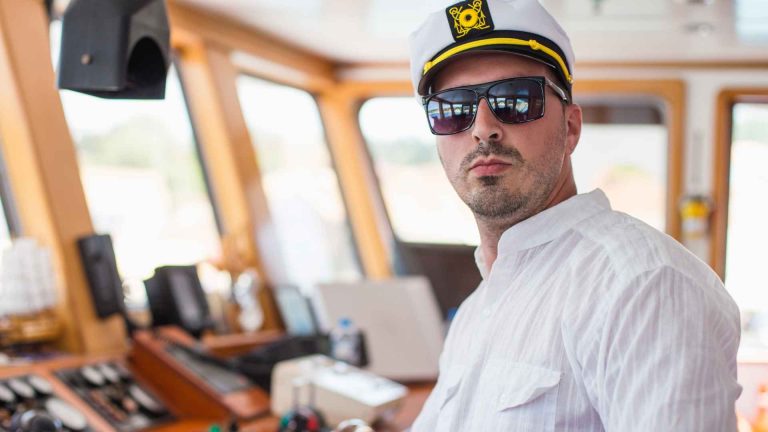
How to Become a Yacht Captain? Step-By-Step Guide
Setting sail on the high seas as a yacht captain is a dream that captivates the hearts of many. The allure of commanding a vessel, exploring breathtaking destinations, and living a life intertwined with the ocean’s vastness is undeniably enticing. However, this coveted role comes with great responsibility and requires a unique set of skills…

Superyacht vs. Mega Yacht: What’s the Difference? Guide
The glimmering azure waters, the gentle sea breeze, and the feeling of freedom as you sail across the open ocean – it’s no wonder that luxury yachts have captured the imagination of many. For those seeking the epitome of opulence on the high seas, the terms “Superyacht” and “Mega Yacht” evoke images of grandeur, extravagance,…

Can You Work on a Superyacht with Tattoos? Guide
Superyachts, the epitome of luxury and opulence, have long captivated the imaginations of those with a taste for the high life. These magnificent vessels, adorned with lavish interiors and offering unrivaled experiences on the open seas, have become a symbol of prestige and exclusivity. But as the allure of superyachts beckons, one question often arises:…
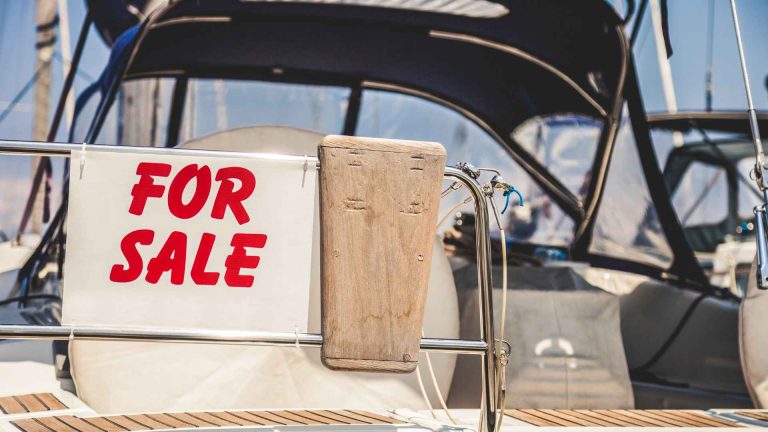
How to Become a Yacht Broker to Sell Your Own Boat? Guide
Becoming a yacht broker to sell your own boat can be a rewarding venture, offering a range of advantages. As a yacht owner, you have firsthand knowledge of your vessel, its unique features, and its history. By taking on the role of a yacht broker, you can leverage your expertise to effectively market and sell…

How Do Yachts Make Money? Exploring 10 Different Methods
Yachts, those luxurious vessels that evoke images of opulence and indulgence, have captivated the imagination of many with their elegance and allure. However, behind their lavish exteriors lies a reality that demands substantial financial commitment. Owning and maintaining a yacht can be an expensive endeavor, prompting yacht owners to explore avenues for generating income to…

Can You Live on a Yacht? and if so, for How Long? – Guide
Living on a yacht evokes images of sun-kissed days, sparkling waters, and a carefree existence. The allure of a yacht lifestyle has captured the imagination of many, with its promises of adventure, luxury, and a break from the conventional. From the glamorous depictions in movies to the envy-inducing social media posts of jet-setters, it’s easy…

Inside Yacht Week
How it works
You've heard us say it's the best week of your life, and you've chosen your dream destination. But how does it all come together? How do you select the perfect yacht? And what's the deal with a host? Here's the lowdown on exactly how you book your week at sea.
Your step-by-step guide
Choose from our yacht categories or pick your own!
Choose your crew; sail with a group or join a shared yacht
Pay & sail; secure your spot for just a 10% deposit
Choose a category or pick your own
Our categories.
Choose from two yacht categories, Classic and Premium, in both Monohull and Catamaran types. Select the one that fits with your crew's spirit and budget, and we'll match you with a yacht that fits the bill. Or, if you're crystal clear about your desires, go ahead and pick your own.
Add your extras
Once you've chosen your yacht, it's time to make it uniquely yours. This is where you can add those exciting extras to turn your week into the dream you've always envisioned. How about adding a host to handle your meals while you soak in the adventure?
Choose your crew
Spend an unforgettable week on a yacht with your very own skipper and up to 12 friends. Can't fill a whole yacht? Use our handy Crew Finder to connect with other travellers.
Go to Crew finder
Set sail with like-minded adventurers in a cabin on a shared yacht.
Masters of the ocean, they’ll navigate and sail your crew, show you the hidden gems en route and ensure your safety is the priority. Skippers are also included with every booking.
- + RYA Skipper License (or equivalent)
- + Trained at YW Skipper Academy
- + Will quite literally show you the ropes if you’d like to learn to sail
Elevate your week to a whole new level with a host. They'll whip up fresh meals for you on deck daily and keep your yacht in pristine condition. Add hosts to any yacht, as long as there's a cabin for them.
- + Culinary genius
- + Local know-it-all
- + Trained at YW Host Academy
Pay and sail
Payment plan.
Pay off your booking in 3 instalments.
Instalment 1 · Confirm booking 10 %
Instalment 2 · 30 days after 30 %
Instalment 3 · 60 days before you sail 60 %
You will only need to pay 10% at the time of booking to secure your space.
- 10% deposit
- 30% of the balance, due 30 days after your booked
- 60% of the remaining balance, due 60 days before your trip
As the lead booker, once you have added your crew to your booking they will create their own profiles and can view the booking and pay their share. That way you won’t have to send money back and forth between everyone in the crew.
Ready to go? Choose your route now
Explore destination.
Dates May - Aug
Price from €613 pp
Croatia Original
Dates May - Sep
Price from €659 pp
Greece Athens
Price from €1,041 pp
Croatia Ultra
Dates 01 - 07 JUNE
Croatia Drumcode
Price from €1,346 pp
Sardinia Refined Route
Sardinia emerald coast.
Dates NEW YEARS
Price from €1,798 pp
Caribbean BVI
Polynesia tahiti.
Ops, looks like there are no FAQ items for ` FAQ `
Excited and ready to go?
Save your summer and sign up
We promise not to spam you
- 672 Wine Club
- Motorcycles
- Car of the Month
- Destinations
- Men’s Fashion
- Watch Collector
- Art & Collectibles
- Vacation Homes
- Celebrity Homes
- New Construction
- Home Design
- Electronics
- Fine Dining
- Gateway Bronco
- Les Marquables de Martell
- Mira Villas
- One&Only
- Reynolds Lake Oconee
- The Ritz-Carlton, Kapalua
- Saratoga Spring Water
- Wynn Las Vegas
- Sports & Leisure
- Health & Wellness
- Best of the Best
- The Ultimate Gift Guide
- Wally Just Launched Its First 110-Foot Sailing Yacht
The new Wallywind110 hit the water on June 1, with the second hull to follow soon.
Rachel cormack.
Digital Editor
Rachel Cormack's Most Recent Stories
- Four Seasons’ Private Jet Trips Will Take You to Asia, Africa, and Beyond in 2026
This New 121-Foot Explorer Yacht Brings Luxury to Bluewater Cruising
- Share This Article

Wally Yachts is entering a new sailing era.
Related Stories
- This Stunning Alfa Romeo Race Car From the 1990s Could Sell for $750,000 at Auction Next Month
- 3 Modern Aircraft That Were Invented in Home Garages
- Porsche Wants to Pay You $4,500 to Buy a Taycan

Founded by Italian entrepreneur Luca Bassani in 1994, Wally initially specialized in sailing boats but has since expanded into building high-tech motor yachts . The new wallywind110, which was fittingly launched on the yard’s 30th anniversary, honors that sailing legacy yet is thoroughly modern in design.
Measuring 100 feet from sheer bow to open stern, the newcomer features a sleek carbon hull, a low-profile coachroof, twin rudders, and a telescopic keel. Showcasing naval architecture German firm Judel/Vrolijk & Co, the first hull is finished in a bright metallic paint that changes color depending on the light.
Wally’s in-house design team worked with Italian firm Santa Maria Magnolfi to create an exterior and interior with a spacious feel. The team decided to relocate all the technical equipment to the stern in order to create a large, 860-square-foot cockpit comparable to that of a sailing superyacht of 197 feet or more. The interior layout includes multiple entertaining areas, an open-plan salon, a full-beam owner’s cabin, three guest cabins, an office, and accommodation for five crew.
The second wallywind110 is already under construction, with delivery expected soon.
Rachel Cormack is a digital editor at Robb Report. She cut her teeth writing for HuffPost, Concrete Playground, and several other online publications in Australia, before moving to New York at the…
Read More On:
- Sailing Yacht
- Wally Yachts
More Marine

This New Custom 169-Foot Superyacht Could Be Yours for $42 Million

This New 164-Foot Hybrid Explorer Yacht’s Pool Can Transform Into a Helipad

Watch: This Compact New 86-Foot Explorer Yacht Just Hit the Seas in Turkey

A Week of Auto Tradition
AUG 14 - 19 Behind-the-scenes access to a remarkable week honoring automotive brilliance.
Give the Gift of Luxury
Latest Galleries in Marine

Meet the 7 Sailing Yachts Competing in Italy’s Upcoming Southern Wind Rendezvous

Project Secret in Photos
More from our brands, pride month celebrates its 25th anniversary: the 2024 fashion collections from companies that give back to support lgbtqia+ community, ai video firm spiideo lands $20m venture capital investment, variety to host three conversations at annecy international animation film festival, two 17th century paintings looted by nazis are donated to the louvre by jewish heirs, the best yoga mats for any practice, according to instructors.
Lillian Fire Rescue saves man from boat fire
LILLIAN, Ala. ( WALA ) - Lillian Fire Rescue said they were dispatched to a boat fire on Perdido Bay this afternoon.
The owner of the boat was in the water with his life vest when officials retrieved him.
The boat owner is in the hospital and is expected to recover, according to Lillian Fire Rescue.
Officials said the boat sank to the bottom of the bay and the Coast Guard has the location marked with a scuttled vessel.
Fire rescue officials tell FOX10 the cause of the fire is still unknown at this time.
Perdido Beach, Alabama Marine Sheriff Officers and Orange Beach PD assisted with the incident.

Copyright 2024 WALA. All rights reserved.

Shelter in place warning lifted; officials give residents the all clear

Woman who was pronounced dead comes back to life at funeral home, sheriff’s office says

Pillans Middle School principal placed on administrative leave

Body of local shrimper recovered from capsized boat in Mobile Bay

Funeral arrangements set for 24-year-old Prichard native who died from cancer
Latest news.

Brazen burglars caught on camera recently

Montgomery triple homicide the latest crime targeting capital city’s Hispanic community

Scattered storms later this evening and Thursday morning, then drier air

First day of testimony in long-awaited murder trial
Car pulled from Charles River near Watertown Yacht Club
WATERTOWN, MASS. (WHDH) - Firefighters are on the scene of a car in the water in Watertown.
The vehicle could be seen close to the edge of the boat ramp at the Watertown Yacht Club on Charles River Road before it was later lifted out of the water by authorities.
Watertown fire confirmed they received a call reporting the submerged vehicle around 6:40 Wednesday morning.
“Upon arrival companies found an unoccupied partly submerged vehicle which had rolled into the river from the parking lot,” the fire department said in a statement.
This is a developing story; stay with 7NEWS on-air and online for the latest updates.
(Copyright (c) 2024 Sunbeam Television. All Rights Reserved. This material may not be published, broadcast, rewritten, or redistributed.)
- 7WEATHER: Summer to Storms
- Jurors hear from forensic scientists, state police investigator as Karen Read murder trial continues
- House Republicans issue criminal referrals against James and Hunter Biden, alleging false testimony
- Jesuit priest, former teacher at BC High, indicted on child rape charge
- 11-month-old boy falls out of second-story window in Stoughton, airlifted to hospital
Orcas threw a yacht around 'like a rag doll' and ripped off both rudders, the latest example of a killer-whale attack
- A pod of orcas attacked a yacht in the Strait of Gibraltar, ripping off both of its rudders.
- The sailor said it felt as though the orcas were throwing the yacht around "like a rag doll."
- There have been 20 incidents of orca attacks in the Strait of Gibraltar in the past month alone.

A British sailor had the rudders of his yacht ripped off by orcas in the Strait of Gibraltar, the latest of several killer-whale incidents in the area in recent weeks.
Iain Hamilton is now marooned in Gibraltar, a British Overseas Territory on Spain's south coast, after a pod of five orcas attacked his yacht, he told BBC Radio 4's "Today" program on Monday.
He said he was sailing 20 miles west off the coast when he noticed a fin near his boat, followed by a series of increasingly jerky bumps.
"There was a very large whale pushing along the back of the boat, trying to bite the rudder," he told BBC Radio 4, adding that the big orca, along with four smaller killer whales, repeatedly bumped against the yacht.
"Then one of them managed to take off the rudder," he said.
Hamilton said it was "quite concerning" to be left with only one rudder, but the situation turned from bad to worse when the second rudder was torn off.
Related stories
"We had no mechanism for steering the boat," he said. Hamilton added that the orcas "pushed us around like a rag doll."
The sailor told Radio 4 that he felt as though the orcas were being "almost playful" rather than aggressive, adding that they would have had the strength to destroy his yacht quickly if they wished to.
He also said the killer whales moved in a way that seemed "choreographed, almost, like synchronized swimming," according to the radio broadcast.
"They seemed to be playing with the rudders, and just inadvertently rendering the boat very vulnerable and in a fairly dangerous situation," Hamilton said in the interview.
It is unclear how the attack ended, or how the yacht got back to shore.
Hamilton went on to tell Radio 4 that the scale of orca attacks on the Strait of Gibraltar is far bigger than one might expect, referring to the Atlantic Orca Working Group's findings that there have been 20 incidents involving killer whales in the region in the past month alone.
Insider's Isobel Van Hagen previously reported on an incident last month in which a pod of orcas rammed a yacht in the Strait of Gibraltar.
In a post on her blog, April Boyes, who was aboard the yacht, wrote a first-hand account of the event. She described the boat filling with water as the orcas "completely destroyed" the rudder.
Researchers are trying to work out why killer whales are increasingly targeting boats near Spain, Portugal, and Morocco, with one theory pointing to a single, female orca who may have been traumatized by a previous interaction.
- Main content
$1 million, 80-foot luxury Sunseeker Atlantis yacht sinks off Florida coast. Photos, what we know

Two people were rescued off the Florida coast Saturday when an 80-foot luxury sports yacht began sinking according to a release from the U.S. Coast Guard in Jacksonville.
Unlike other recent incidents in other parts of the world, no orcas were involved in this yacht going down. The operator reported that the boat hit something in the water.
At 11:37 a.m. the operator of the yacht radioed that they were taking on water three miles off the coast of St. Augustine Beach. Multiple agencies responded, the Coast Guard said.
When marine units from St. Johns Sheriff's Office and St. Augustine Police Department arrived, the boat was already partially submerged. Two people were safely removed.
“We extend our heartfelt gratitude to our partner agencies for their invaluable assistance during this case," said U.S. Coast Guard Senior Chief Petty Officer Ricardo Santacana. “With the weather improving and mariners heading out onto the water, it's imperative for everyone to verify the presence of all necessary safety equipment aboard their vessel. This ensures that responders, as demonstrated in this case, can swiftly locate you and render assistance when an emergency arises.”
Here's what we know.
Why did the Sunseeker Atlantis yacht sink off the coast of Florida?
According to the operator of the boat, it struck something.
St. Johns County Fire Rescue reported it was a dredge pipe piling and a photo of the piling shows a bent sign.
Was anyone hurt when the Sunseeker Atlantis yacht sank?
One person suffered minor injuries and was taken to a local hospital in stable condition, St. Johns County Fire Rescue said in a Facebook post .
What kind of yacht sank off the St. Augustine Beach coast?
The boat appears to be a Sunseeker Atlantis , built in the United Kingdom and delivered in 1999, according to Boat International.
The motor yacht is one of 21 Predator 80 models. It has two Caterpillar diesel engines, a top speed of 45 knots and a cruising speed of 40 knots, with room for up to six guests in three staterooms, plus two crewmembers.
The yacht was designed by naval architect Don Shead, with interiors from designer Ken Freivokh, Boat International said. Similar Sunseeker Predator 80 yachts have been listed for around $1 million.
What will happen to the Sunseeker yacht Atlantis?
A hazard has been issued to alert others of the partially submerged vessel.
The owner of the boat will arrange salvage and the cause of the incident is under investigation, the Coast Guard said.

IMAGES
VIDEO
COMMENTS
The main points of sail are: Close-hauled: Sailing as closely as possible into the wind. This requires the sails to be trimmed in tightly, and the boat moves forward at an angle against the wind. Close reach: Sailing diagonally to the wind, between close-hauled and a beam reach. Beam reach: Sailing perpendicular to the wind.
Tacking and jibing (gybing) A boat changes direction by either tacking or jibing. Sailing upwind, a boat tacks when the bow passes through the eye of the wind until the boat is sailing on the opposite side or "tack" creating a zig-zag course. When sailing downwind, the boat jibes when passing the stern through the wind.
Sailboats use the power of the wind to propel them forward. The sails are designed to catch the wind, and as the wind passes through the sails, it creates lift which moves the boat forward. The sails can be adjusted to different angles to maximize the lift and the direction of the boat. The rudder is used to steer the boat and the keel helps to ...
Northern California has a storied, 500-year history of sailing. But despite this rich heritage, scientists and boat designers continue to learn more each day...
Know how: Sailing 101. To begin You don't need to know much about how a piston engine works in order to drive a car. You get in, turn on the engine, shift into gear, step on the gas, and off you go. In a sailboat, though, you play a far more active role in harnessing the energy that propels you forward. You can get.
Any yacht designer will tell you there's much more to getting the correct forward vector. And this is true. The shape of the hull, the smoothness of the bottom, and a few other factors will affect the final forward forces on the boat. But at its core, the lift vector from the sails added to the keel vector ends up in the boat being pulled forward.
How lift actually works: http://www.youtube.com/watch?v=aFO4PBolwFgMore with Canadian Olympian Hunter Lowden: http://www.youtube.com/watch?v=6YVOPUkbu6gHow d...
The sail creates a low pressure zone in front of the sail and a high pressure zone behind the sail. The boat moves into the low pressure zone and is sucked forward. This is very like the idea of an aeroplane wing, which is curved in a similar way to a sailboat's sail as you can see below. In airplane wings, the pressure on the top of the wing ...
With no load onboard, the ship sinks into the water by a certain amount. The amount of water it displaces (shaded area) weighs as much as the ship. The weight of the ship pulling down (red arrow) and the upthrust pushing up (blue arrow) are equal and opposite forces, so the ship floats.
The common sailboat comprises eight essential parts: hull, tiller, rudder, mainsail, mast, boom, jib and keel. The hull is the shell of the boat, which contains all the internal components. Its symmetrical shape balances the sailboat and reduces drag, or the backward pull caused by friction, as it moves in the water.Inside of the hull in the stern, or back of the boat, is the tiller, which is ...
The F50 is an awe-inspiring racing machine capable of reaching speeds up to 50 knots (60mph/100kph). The team who designed and built the fleet explains what ...
To build a faster boat you have to find ways to overcome the drag force. The first mechanism is friction. As the water flows past the hull, a microscopic layer of water is effectively attached to ...
Drawing by Tosaka. The primary force holding an anchored ship in place is the weight of the chain on the bottom of the sea. The wind will push the boat away from the anchor and keep the chain in place. Most anchors have flukes designed to dig into the ground. If the anchor is in the correct position, it will dig in deeper when wind or waves put ...
Inexperienced yacht crew working as deckhands or stewardesses can earn between $2000-3000 a month. With more experience and higher positions, your salary can be between $3500-$6000 a month. On charter trips, guests typically tip 5% - 15% of the weekly charter fee, which is split between crew members.
Autopilot for Sailing Yachts. Sailing yachts often benefit from autopilots, which can adjust sails and maintain course even when sailing close to the wind. This ensures a smoother and more enjoyable sailing experience. Sailing Yacht A Cost "Sailing Yacht A" is an example of a luxury sailing yacht equipped with advanced autopilot systems.
The principle of operation of the other most common gearbox, the layshaft, is similar to the two-shaft box, but a separate shaft - the layshaft - is used. One clutch is mounted on the input shaft and the other on the layshaft. The output shaft rotates in the same direction as the engine in forward gear. These gearboxes normally use ...
The key to land yachts is how they are propelled. It uses the power of the wind to move the vehicle, much like a sailboat does in the water. This is done by mounting a large sail to a rotating mast that can be adjusted to catch the wind. The wind then fills the sail, providing thrust and pushing the yacht forward.
Much of a deckhand's work is performed on the outside of the boat. Therefore, as a deckhand, you would be doing a lot of manual labor outside. This can be helpful to keep in mind when deciding if working as a deckhand is right for you. Deckhands usually make between $27,000 and $55,000 per year. 3.
Imtra thruster expert Peter Nolet explains the basics of bow and stern thrusters and how they work. Since the 1990s, recreational boats have increasingly been equipped with extra propulsion devices that are commonly called bow, stern, or side thrusters. Thrusters are equipped with small propellers that help maneuver a boat sideways rather than forwards or backwards, typically while docking or ...
Yachting is an eye opening, ultimately fun industry that demands hard work, perfection and attention to detail. We work with yacht crew every day and have a deep insight into what new crew should do to make the most of their career. Here are our top ten tips for starting out. Starting Out Guide - Europe Crew Training Manual.
A hydrofoil boat is a watercraft equipped with wing-like structures mounted beneath the hull. The hydrofoils generate lift as the boat accelerates, causing the hull to rise above the water's surface. Decreasing the hull's contact area with the water helps to reduce hydrodynamic drag and wave resistance and increases fuel efficiency.
A yacht autopilot utilizes electronic sensors, control algorithms, and actuators to maintain the boat's desired course. It receives input from various sources like GPS, compass, and wind sensors, processes the data in the control unit, and sends signals to the steering mechanism or sails to make real-time adjustments.
The tips depend on the size of the Yacht and the guests, but a good estimate is 10 - 20% of the total weekly price of a Yacht. If you imagine a 50m (165 foot) Yacht with 9 crew, it typically charters for $150,000 - $250,000 per week. For simplicity, let's add a 15% tip for $200,000/wk.
Your step-by-step guide. 1. Choose from our yacht categories or pick your own! 2. Choose your crew; sail with a group or join a shared yacht. 3. Pay & sail; secure your spot for just a 10% deposit. 1.
The 110 offers not only the comfort of a cruiser but the speed of a racing yacht, too. Powered by 355 hp Cummins engines, the sloop makes quick work of ocean crossings, according to Wally.
Published: Jun. 4, 2024 at 5:45 PM PDT. LILLIAN, Ala. ( WALA) - Lillian Fire Rescue said they were dispatched to a boat fire on Perdido Bay this afternoon. The owner of the boat was in the water ...
The vehicle could be seen close to the edge of the boat ramp at the Watertown Yacht Club on Charles River Road before it was later lifted out of the water by authorities.
Orcas threw a yacht around 'like a rag doll' and ripped off both rudders, the latest example of a killer-whale attack. A pod or orcas, or killer whales, with a baby orca among them. Getty Images ...
2 rescued from sinking 80-foot yacht off St. Augustine Beach, Florida. Two people were rescued Saturday after the luxury yacht they were on started sinking three miles off St. Augustine Beach, the ...
At 11:37 a.m. the operator of the yacht radioed that they were taking on water three miles off the coast of St. Augustine Beach. Multiple agencies responded, the Coast Guard said. When marine ...